

MAIN COURSES









Chef’s Table 030
The Brazilian-Italian chef, who helms the kitchen at the two-Michelin-starred Da Terra at Town Hall Hotel, shares his favourite food memories.
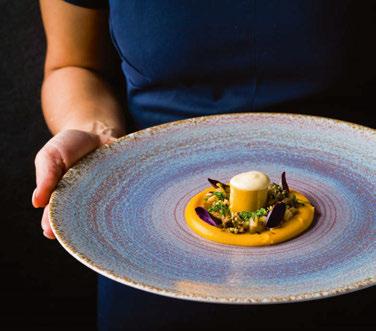
032
Ahead of his London debut, Yannick Alléno reveals more about the neighbourhood-style restaurant concept coming to Four Seasons Park Lane, and why he finally feels ready to take on the UK market.
040
As Makeready continues to expand its portfolio, the group’s President and Chief Operating Officer discusses placemaking, community connections, and staying true to brand concept.
Obsession 23 068
23 world-class chefs descend on Lancashire to showcase their skills at Northcote’s annual culinary festival.
Free Rein 074
Ennismore’s integrated F&B studio Carte Blanched is reimagining the bespoke drinking and dining development process, with impressive results.

Martini
084
The Martini is enjoying a well-deserved moment in the spotlight, so how are hotel bars putting their own spin on one of the world’s most iconic cocktails?

SIP – Share. Inspire. Pioneer. 096
Bringing the industry together, Pernod Ricard launches a new trade advocacy platform designed by the hospitality community, for the hospitality community.
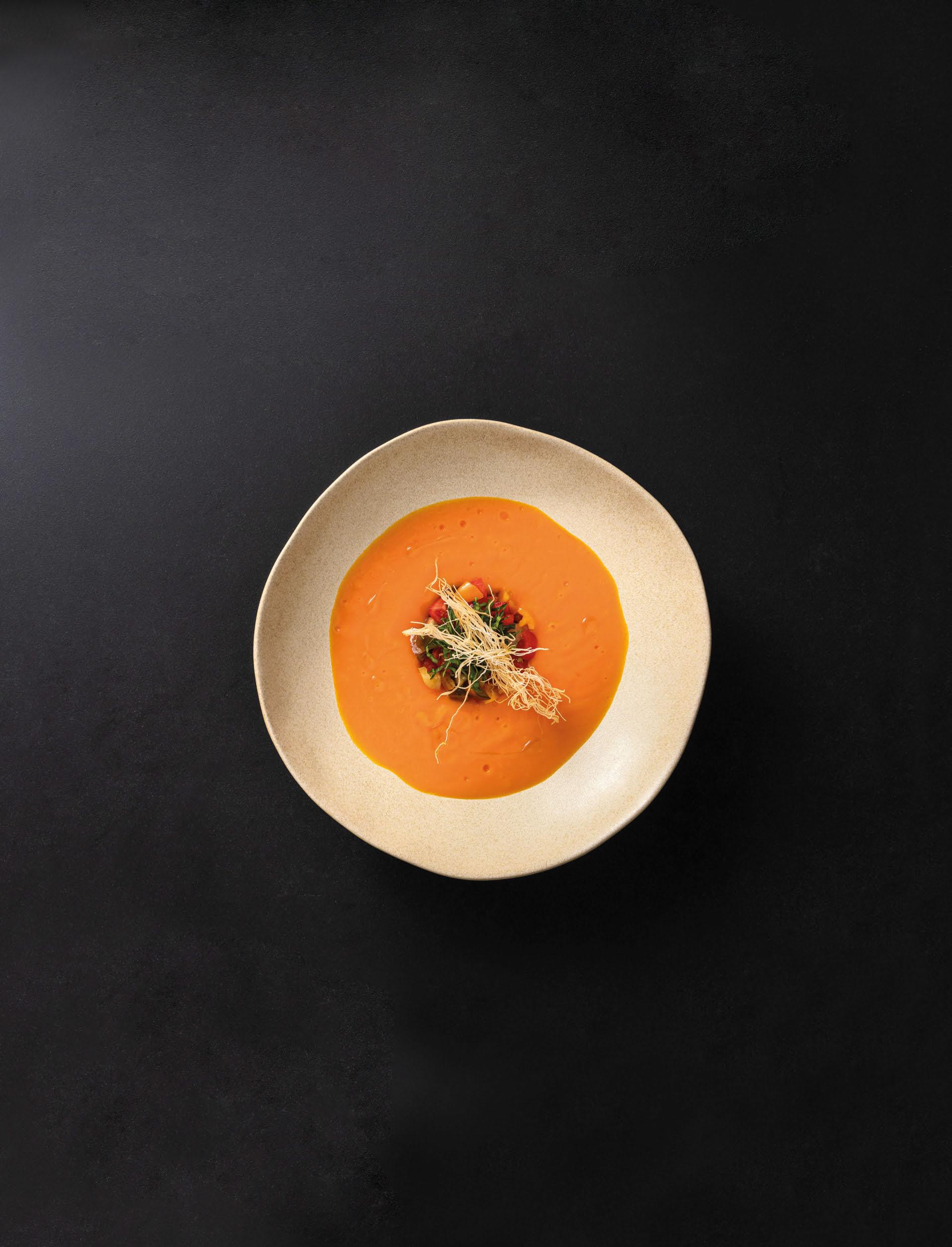




















































































































































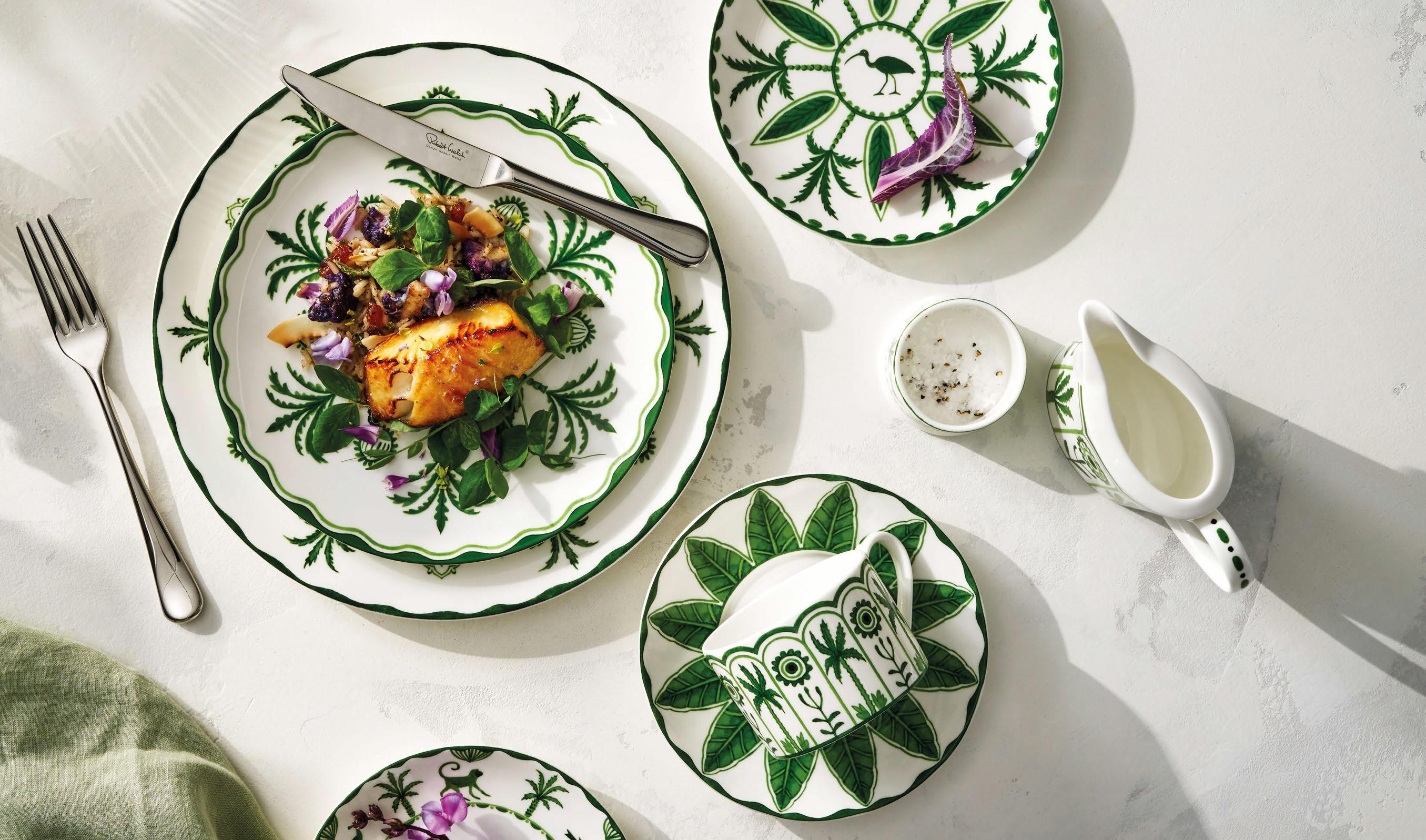






Designed in Miami, stocked and shipped worldwide.
learn more

The new Mytico line brings excellence to life in every detail. Game-changing coffee solutions that deliver impeccable Italian design on the outside and Franke’s Swiss quality on the inside.
Go BeyondTraditional and unlock more potential for your coffee business with Mytico. Stand out from competition and convince customers to come back for more.








 Explore the 1862 Vienna concept!
Explore the 1862 Vienna concept!



If there’s one good thing to have come out of the pandemic, it’s undoubtedly the support that businesses are now giving one another to rebuild, grow and prosper. Even when a peer could be classed as the competition, there’s an overwhelming feeling of having the support of a nation.
Throughout the course of putting this issue of Supper together, messages of support began emerging from the pages, with hotel operators, chefs and suppliers often unintentionally hitting on what makes this industry special as they told of their new concepts. At Ennismore, where an integrated F&B studio is reimagining the drinking and dining development process, the trio of leaders at the helm explain how nurturing new talent lies at the heart of their ethos, the aim being to support such independents in building their brand, all the while bringing new restaurant and bar concepts to Ennismore’s growing collection of lifestyle hotels.

Also showing its support of the sector, Pernod Ricard tells of the trade advocacy platform it has launched to further the careers of bartenders, F&B managers and nightlife operators, providing content, events and training to make for a more prosperous future for all. Coming together for in-person events certainly has a newfound appreciation following the enforced era of the video call, as Supper found at To The Table, which recently took place in Abu Dhabi; there was a sense of sharing across the three days, whether it be in the practical advice given by leaders in the seminar sessions, or in the introductions made to project leaders on the look-out for suppliers.
Chefs too have been making an extra effort to support one another. For the 2023 edition of Northcote’s Obsession festival,
Lisa Goodwin-Allen shone the spotlight on both established and emerging chefs, giving the latter in particular a stage on which to showcase their culinary skills – not to mention raise a huge amount of money for Hospitality Action.
And when Supper caught up with Yannick Alléno – the French chef soon to make his London debut with a neighbourhoodstyle eatery at Four Seasons Park Lane – he revealed how the city has welcomed him with open arms, with top chefs calling to offer up their best contacts for sourcing British produce. Speaking to Alléno from his base in Paris, it was clear that such a show of support carried weight.
These examples are a timely reminder of the very reason this magazine first launched. When Issue 1 was released in 2016, we spoke of the elements that go into creating a memorable guest experience, from the interior design of a restaurant or bar, to the chef’s cuisine and the tableware on which it is served. Our objective was to showcase the talents of all F&B professionals, to inspire and to connect communities. This ambition still stands. Indeed, there have been many challenges since those early days. And like you, we have faced challenges too – after all, we only exist if new hotels are being built. But by continuing to support one another, we can collectively ensure a prosperous future for the world of hotel F&B. We hope you enjoy this latest issue. Supper is served.
Catherine Martin • Managing EditorEDITORIAL
Editor-in-Chief
Matt Turner m.turner@mondiale.co.uk
Managing Editor
Catherine Martin c.martin@mondiale.co.uk
Assistant Editor
Eleanor Howard e.howard@mondiale.co.uk
Editorial Assistant
Cara Rogers c.rogers@mondiale.co.uk
ADVERTISING
Advertising Manager
Rachel Chadwick r.chadwick@mondiale.co.uk
DESIGN
Design Manager
David Bell d.bell@mondiale.co.uk
Production Mel Capper m.capper@mondiale.co.uk
EVENTS & MARKETING
Commercial Lead Kirsty Studholme k.studholme@mondiale.co.uk
Events Co-ordinator
Olivia Mavers o.mavers@mondiale.co.uk
Data & Marketing
Lauren Blain l.blain@mondiale.co.uk
Subscriptions enquiry@sleeper.media
FINANCE
Finance Director
Amanda Giles a.giles@mondiale.co.uk
Group Financial Controller
Sarah Healey s.healey@mondiale.co.uk
Group Credit Controller
Lynette Levi l.levi@mondiale.co.uk
Accounts Assistant
Kerry Dolan k.dolan@mondiale.co.uk
CORPORATE Chairman
Damian Walsh


“We have always envisioned a way of life that centres around cultivating our own fruits, vegetables and herbs,” explains Alexandra Efstathiadou, owner of Ekies All Senses Resort on the unveiling of an organic farm within the grounds of the Halkidiki hotel. “This dream has come to fruition with the growth of our garden, which includes fruit trees, herb beds and a newly established organic vegetable farm. Over the next four years, our goal is to grow 100% of the vegetables we use in our kitchens, improving the quality of our products while reducing our impact on the environment.”
The venture is the result of a partnership with The Chill Factor, experts in organic farming, who have provided knowhow in which varieties of crops – ranging from microgreens to edible flowers – will best cultivate a farm-to-fork strategy for the hotel’s restaurants. “Sustainability and viability are amongst the values we cherish most in the kitchen,” says
Chef Dimitris Pamporis. “The farm not only caters to that, it also provides us with the ingredients to present an even tastier and healthier menu.”
For Pamporis, the farm will allow for a varied menu that changes with the seasons. “One of my favourite dishes that comes straight from the farm is a salad made using different types of tomatoes we grow,” he explains. “It’s a vegan dish of water-iced tomatoes and spicy peppers marinated in basil, served with the juice of a watermelon, and decorated with microgreens like basil flowers and cappuccino leaves. It is a unique experience for a chef to cut fruit from the tree or take the vegetable out of the earth and cook it a few minutes later.”
Green-fingered hotel guests will also be able to get a taste of the experience, participating in planting and harvesting activities, plus there are plans to host special dinners in the greenhouse, bringing new meaning to farm-to-fork.
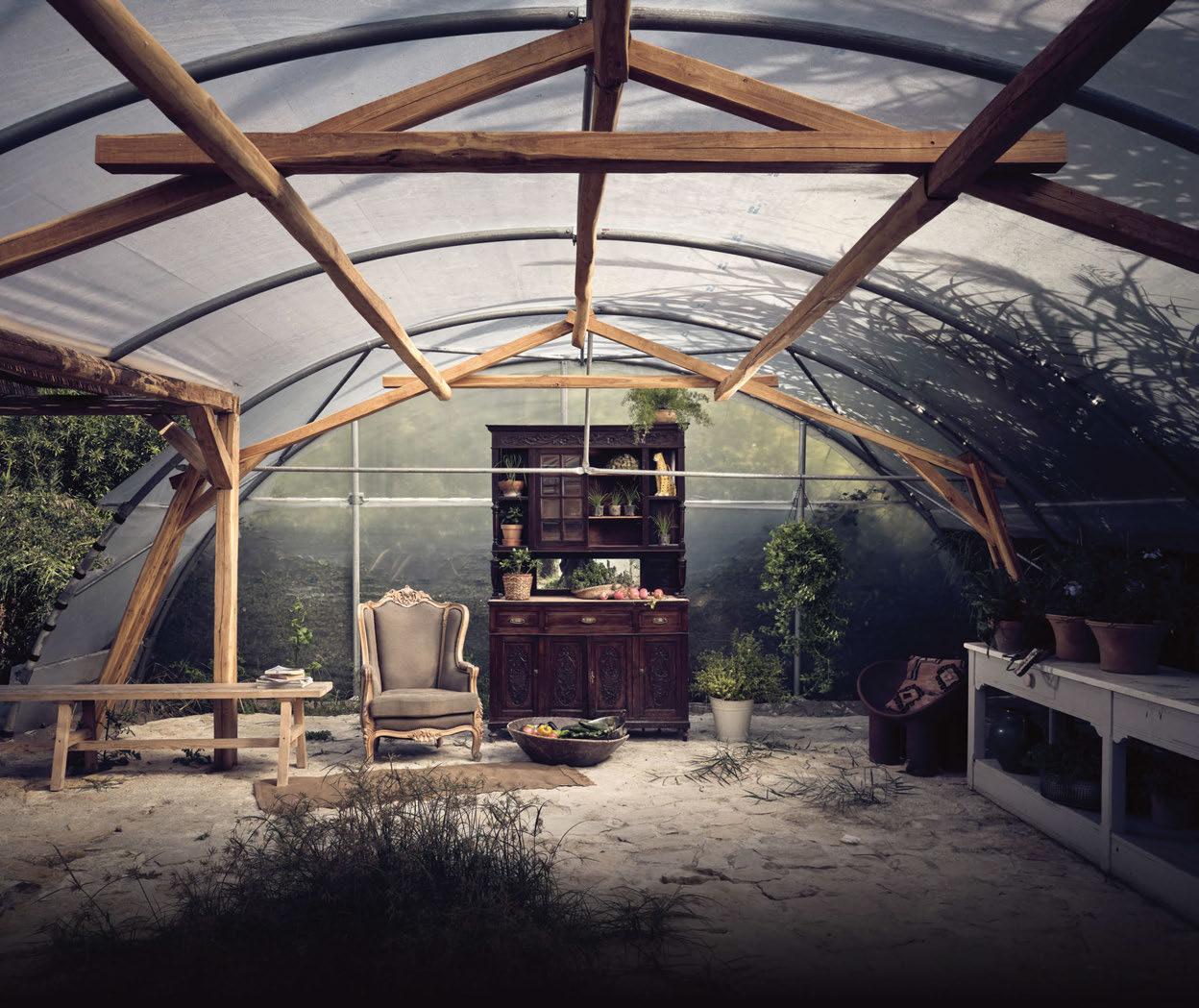
From traditional tapas to cutting-edge cuisine, Spain has long been renowned for its culinary offering, with the likes of San Sebastian, Madrid and Andalucia attracting foodies from around the world. Now, the Canary Islands is determined to make a name for itself as a gastronomic destination, with hotel dining leading the way. Of the hundreds of hotels on the archipelago, Spanish hospitality chain Barceló Hotel Group is among those with the greatest number of Michelin stars in the Canary Islands, having received three new accolades in the 2023 Michelin Guide for Portugal and Spain.
Tenerife’s grand dame hotel El Rincón de Juan Carlos at Royal Hideaway Corales Resort was recently awarded a second Michelin star, bolstering the island-native Padrón brother’s reputation for offering an authentic gourmet experience. And the hotel’s Peruvian-Japanese fusion restaurant San Hô was awarded its first star in recognition of the work of chefs Adrián
Bosch and Eduardo Domínguez, also originally from the island, who have put a local twist on Nikkei cuisine. Now, the resort boasts a total of three Michelin stars, cementing its status as one of the best gastronomic hotels in the country.

Emblematic Santa Catalina, a Royal Hideaway hotel in Gran Canaria, retained its Michelin star at Poemas, the restaurant led by the Padrón Brothers, which was first achieved back in 2022 and marked the first in the city of Las Palmas de Gran Canaria.
And on mainland Spain, Granada celebrated another milestone when La Finca at La Bobadilla, a Royal Hideaway hotel was awarded its first Michelin star – also a first for the Andalucian region. With a total of five stars across Spain, Barceló is demonstrating its commitment to gastronomy and solidifying the Canary Islands as a culinary destination, producing both top quality food and chefs: in fact, all the award-winning chefs are of Canary Islands origin.
“These books are designed for my younger self. It’s everything I would have wanted to know when I was starting out in my career,” reveals Michelin-starred chef Adam Handling, author of a new recipe book collection. Ten years in-themaking, the boxset comprises ‘Frog by Adam Handling’ – based on the chef’s flagship restaurant; ‘Why Waste?’ – a collection of sustainable, zero-waste recipes with a guide to sustainability and using seasonal produce; and ‘Perfect, Three Cherries’ – a cocktail book featuring a raft of recipes described as a sustainable take on the classics. Together, the trilogy tells Handling’s story, the journey of his restaurant group, the road to his first Michelin star and his sustainability ethos. Alongside ingredient and produce maps, there are also contributions from industry figures such as Pierre Koffmann, Alex Dilling and Charlotte Hill OBE. “This collection started as one book, showcasing Frog, but the more we dove into it, the waste book and cocktail book became clear. It’s the stuff that people don’t see behind the scenes – the researching, the training, the things we had to do to make Frog what it is today. To understand what Frog is, you need to understand the waste element, the foraging, the sustainability, provenance of ingredients, everything.”

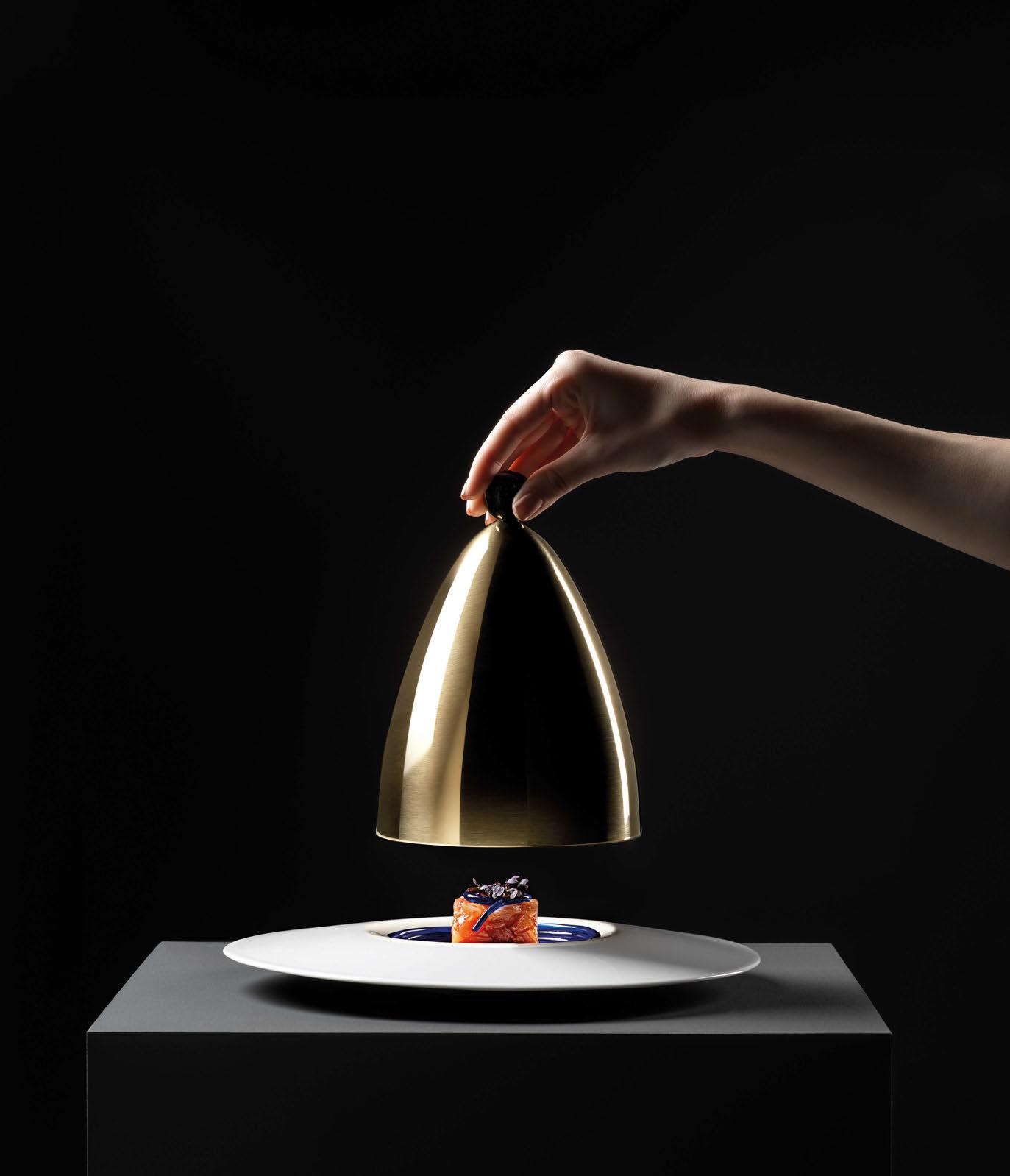
Unusual flavour combinations, mindful proteins and upcycled ingredients are just some of the food trends identified by Unilever Food Solutions in its inaugural Future Menu trends report 2023. The professional foodservice business teamed up with more than 1,600 chefs in over 21 countries to compile eight core themes based on global data and social media analytics, personal inputs and the expertise of chefs who offer practical applications.
“Identifying the hottest global trends is critical in our quest to provide solutions for chefs, who are contending with challenges ranging from labour shortages to tackling sustainability issues like food waste,” comments Hanneke Faber, President of Nutrition Unilever. “With the release
healthy makeover according to Unilever, with chefs looking to create new spins on classic dishes. “Diners love to rediscover those dishes they know well in a new guise that keeps faith with the past but with the reinterpretation of possible ingredient combinations, cooking methods and above all, presentation,” explains Executive Lead Country Chef Giuseppe Buscicchio.
Chefs tip ‘wild and pure’ ingredients to impact menus too. The likes of edible flowers, wild berries and even seaweed have the potential to connect diners to their locale, whilst also lowering food miles. “As a chef, it is always great to discover new ingredients and even greater when you can pick them yourself,” states Culinary Advisor Wesley Bay. “Native ingredients
of the Future Menus trend report, Unilever Food Solutions is not just sharing future trends, but also offering solutions-based insights and adaptable recipes to inspire chefs and help them feel prepared for the future.”
One of the first trends identified by Unilever is unique combinations of flavours, colours and textures that spark unexpected, multi-sensory dining experiences. “Guests are always curious about exciting combinations and flavours; they want to be surprised,” explains Head Chef Edwin van Gent, a member of the UFS team in the Netherlands. “Eating should be an experience.”
Unilever also believes that the growth of sharing plate menus presents a chance for chefs to experiment with new fusions of flavours and cuisines, as Executive Chef Sherif Afifi notes: “It’s an opportunity for us chefs to generously share our regional flavours and techniques with the diners for them to have a great experience with their loved ones.”
Much-loved comfort foods are also set for a
offer chefs more space for creativity and allow them to work seasonally.”

UFS also expects to see a renewed focus on sustainability through reducing food waste and using alternative protein sources. The former sees techniques such as pickling, curing and fermenting give a second life to previously discarded by-products, whilst the latter sees the use of plant-based meat as a way of reducing the environmental footprint of a dish. Vegetables are also expected to take on a leading role on the plate. “Cooking more with vegetables doesn’t just add more nutrients to the dish but also expands your menu options,” notes Chef RenéNoel Schiemer. “Therefore, you have the chance to bring a new clientele into your location.”
Featuring recipes and menu suggestions, each of the eight trends within the report present opportunities for more nutritious and sustainable ingredients, lower carbon footprint and culinary techniques that bring out the best flavours in every dish.
A new report from Unilever Food Solutions predicts eight trends set to influence restaurant menus over the next 12 months.


The Brazilian-Italian chef, who helms the kitchen at the two-Michelin-starred Da Terra at Town Hall Hotel, shares his favourite food memories.
When did you first fall in love with cooking?
My family has a history in food and hospitality. My mother used to work in catering and owned a restaurant and jazz bar in São Paulo, so I grew up around the industry. When I was studying in London, I took a job as a pot wash and cook at a local brasserie; eventually, I realised I enjoyed the kitchen more than my studies and with the encouragement of my head chef, I decided to go to culinary school instead.
Which chefs have inspired you?
After culinary school, I worked with some chefs who have had a huge influence on my career, such as Quique Dacosta, Martin Beresategui, Heston Blumenthal and Simon Rogan. Their passion and creativity helped me realise how much I wanted to be a chef.
What’s your favourite hotel restaurant?
The restaurant at Grand Hotel a Villa Feltrinelli in Lake Garda. I used to work there with Stefano Baiocco and it was an incredible experience. He showed me the meaning of determination and passion. Running a restaurant comes with many challenges and he never gave up on what he wanted to achieve.
How often do you dine out?
Not as often as I would like! My husband Charlie and I are at Da Terra for every service of the week, so that only leaves a few free evenings and they fall on days when lots of other great restaurants are closed too. Whenever I travel, I always make sure I try a few different places.
Which new restaurant are you eager to try out? Terre, the new restaurant at Castlemartyr Resort in Ireland. Vincent Crepel has worked with some talented chefs and the food looks beautiful. I like the idea of going somewhere remote and having an incredible dining experience.
Are you an easygoing or demanding diner?
I think I’m quite an easygoing guest. Of course, my standards are quite high, but when I go out to eat, I want to have fun. I like restaurants that are made up of various elements, which work together to create something special.
Tell us about your most memorable meal?
The most memorable meal of my life was at Chef’s Table at Brooklyn Fare in New York –a flawless experience from start to finish. The simplicity and great produce showcased Cézar Ramirez’s cuisine very well.
It’s Sunday evening at home: who’s cooking and what’s on the menu?
I’ll let Charlie do the work, he’s good at cooking British classics – he does an incredible roast.
What’s your favourite dish, and who cooks it? My mum’s chicken stroganoff. Every time I go back to see my parents, it’s a must!
And something to drink with that?
A sloe gin negroni or some cachaca.
Which city is food heaven for you?
São Paulo is a place where I eat out as much as
I can. Brazilians love to eat so the city has an amazing array of restaurants covering a wide variety of cuisines.
Where do you get the creative inspiration for your dishes?
Each of my dishes is based on a memory, inspired by Brazil or the great places I’ve worked in the past. Having Italian heritage and working in Italy has really cemented the pillars of Italian cooking as an important reference point for the way I think about food – at Da Terra, we have had pasta in some form on the menu for almost the entire time we have been open. Working with Martin Berasategui in Spain also taught me a lot about how to establish a unique experience through your own cultural framing. I also had the pleasure of working with both Heston Blumenthal and Simon Rogan in the UK – seeing how they worked with British produce was an inspiration.
Which cookbooks can we find on your shelf? Modernist Cuisine is a great technical book. You can immerse yourself in it then suddenly realise you have all five books open at once.
Restaurant dining or room service?
Restaurant dining all the way.
Healthy dishes or full-fat indulgence? Full-fat indulgence.
Sweet or savoury?
Sorry, but I have to say both.

Ahead of his London debut, Yannick Alléno reveals more about the neighbourhood-style restaurant concept coming to Four Seasons Park Lane, and why he finally feels ready to take on the UK market.
I’m stressed,” says Yannick Alléno, as we sit down to discuss his highly-anticipated debut at London’s Four Seasons Park Lane. We had arranged to meet at the hotel – an informal rendezvous and perhaps take a sneak-peek at the under-refurbishment restaurant that would soon carry his name. But alas, the train strikes that have been plaguing Europe scuppered our plans, so make-do with a video call. “With every passing day, I’m getting more and more stressed,” he affirms – an understandable response given the complexities of opening a new restaurant, not to mention one that occupies a prestigious hotel in a soughtafter capital city location. “London is a very tough market,” Alléno continues, alluding to the variety, quantity and quality of dining options in the city. “There are so many fantastic chefs and so many great restaurants; to open in London, you really have to be sure you’re at the right level.”
While Alléno may have questioned whether he has reached the “right level”, his credentials surely come as confirmation. As one of the most decorated chefs in France, he holds no less than 15 Michelin stars across his global portfolio of restaurants – Alléno in Paris was awarded the ultimate accolade of three stars in 2015, while Le 1947 at Cheval Blanc in Courchevel won the same recognition in 2017. There’s also Pavyllon Monte Carlo at Hôtel Hermitage and Fre at Réva Resort in Monforte d’Alba, with a Michelin star each, and Stay at One & Only The Palm in Dubai with two stars. Alléno’s portfolio extends to Asia too; the chef heads up Stay, a modern French restaurant at Signiel in Seoul, as well as cuisine at the hotel’s Bar 81 and The Lounge venues.
In all, Alléno has put his name to 14 restaurants around
the world, a portfolio that continues to grow. And though he’s experimented with various styles over the years, the chef is best known for his reinvention of modern French cuisine, an approach he defines as being rooted in French gastronomy, yet inspired by contemporary techniques and seasonal ingredients.
The origins of Alléno’s craft can be clearly traced back to childhood; as a youngster, evenings and weekends were spent at bistros that his parents ran in the suburbs of Paris, and so when his grandmother taught him to cook at the age of eight, he immediately realised he wanted to be a chef. At 15, Alléno got his first job in a professional kitchen, initially learning from Gabriel Biscay at Le Royal Monceau, before working with French greats including Roland Durand and Martial Enguehard at the former Sofitel Paris Porte Des Sevres and Louis Grondard at Drouant. Having refined his skills, Alléno was appointed Head Chef for Les Muses at L’hotel Scribe, where he was awarded his first Michelin star. He then joined Le Meurice as Chef de Cuisine, and through a decade-long tenure became regarded as one of Paris’ best.
Alléno’s first solo venture came in 2014, when he took ownership of Pavillon Ledoyen, a majestic Neo-Classical building on the Champs-Elysées. Here, he opened Alléno Paris, which gained its three stars only seven months after opening. The Pavillon has a longstanding history as a temple of gastronomy, and as the birthplace of Alléno’s empire, it now houses three of his restaurants. In 2018, he added L’Abysse, a 12-seat sushi counter concept developed in collaboration with Yasunari Okazaki, a sushi master he met on one of his many culinary voyages to Japan. And in 2019,

Pavyllon London is set to be a British expression of Alléno’s signature modern French cuisine
he opened his third and final restaurant in Pavillon Ledoyen – Pavyllon. This, his most casual concept, focuses on seasonal dishes that combine French influence with other culinary traditions; cooking on a teppanyaki for example, or preparing seafood the Nordic way.
And it’s this concept that brings Alléno to the UK. So is a presence in London a long-held ambition?
“Ahh…” he sighs, signifying that the city has been a goal for quite some time. “I love London and I love the energy of the city,” he continues, adding that there have been offers before but they didn’t work out. I ask why – difficulty in finding the right site or the right partners, perhaps? “I was not ready for the market,” he quips in another hint of self-doubt.
“I’m 54 now, so I think I am okay; Pavyllon is now mature enough and I am mature enough to work in the English market.”
His calling came with news that Four Seasons was on the lookout for a casual yet refined eatery for its Park Lane property. Given that the majority of his restaurants sit within hotels, Alléno clearly has an affinity for the hotel setting, describing himself as “more comfortable” within the support system that a global operator offers. But not just any operator. Four Seasons is a group he holds in high esteem. “Four Seasons is a leading luxury brand with a fantastic portfolio; it was one of my targets in terms of brand development,” he explains. The opportunity arose through a network of connections that led to meetings and subsequent tastings with both owner and operator. Alléno also credits the successful partnership to the team on the ground, notably Lynn Brutman, Regional Vice President and the hotel’s General Manager. “When the planets align, we can do fantastic things,” he says of the fruitful combination of the right brand, the right location and the right people.
With Pavyllon London set to open this summer, Alléno reveals that the aim is to create a refined, neighbourhood-style restaurant that welcomes everyone, whatever their budget or dietary preference. “We want to bring Four Seasons Park Lane back to
the city,” he explains, alluding to a general desire amongst luxury hotels to be more accessible. “That’s what I did with Pavyllon Paris – it’s a destination for Parisians, where anyone can come to meet and dine. Pavyllon London will follow that same philosophy.”
The approach reflects Alléno’s belief that restaurants form the backbone of a city’s social scene, and so in London, the menu is designed to appeal to a diverse range of occasions, from leisurely lunches to celebratory dinners. Though the chef remains tightlipped as to exactly what’s on the menu, he whets the appetite with the promise of “a British expression of my signature modern French cuisine” revealing that seasonal British produce is key to the offer: “There are so many good providers in England – the meat is fantastic and the fish is the best in Europe; the result will be a combination of these products and my French touch.”
Indeed, Alléno will have no problem in finding quality produce. Since Pavyllon London was announced, the chef has been inundated with offers of support. “Clare Smyth, Jason Atherton and Claude Bosi all called to offer help in finding suppliers,” he explains. “I was very proud of that, it’s good to feel welcomed in such a way.”
The menu at Pavyllon London will also be in keeping with the core pillars that have come to define Alléno’s cuisine. For example, he strongly believes that chefs have a responsibility to look after the health of their guests, and so strives to reduce the amount of sugar, fat and salt in his dishes – without compromising flavour, of course. And there’s also the importance of sauces, made using a patented Extraction technique developed by Alléno in 2013 with the help of a scientist, in which a precise cooking temperature safeguards ingredients from destructive heat, bringing natural flavours to the fore and giving a textured finish. These approaches can be found on the menu at Pavyllon Paris, in dishes such as vegetable ravioli with spring extraction broth and perfumed oils, and Alléno’s interpretation of the French classic – soufflé steamed with Comté and celery extraction. Pavyllon London
“There are so many fantastic chefs and so many great restaurants; to open in London, you really have to be sure you’re at the right level.”
will follow the same approach, and diners can expect a greater variety of dishes along with an equally well-considered wine offering. While ingredients and flavour combinations are undoubtedly of utmost importance, this is a chef who knows that dining out is about more than what’s on the plate. Alléno talks at length about the interiors of his new restaurant, to the same level of detail as if he were the designer himself. He has in fact been closely involved, enlisting long-time collaborator Chahan Minassian to take the lead on the design of the space, building on his schemes at Pavyllon’s Paris and Monaco outposts. Minassian has been quoted as saying “our approach is the same; his is on the plate, mine is with space”– to which Alléno wholeheartedly agrees, revealing a shared belief that they complement one another. There’s also a commonality in putting the guest first to ensure the entire dining

experience is enjoyable. “We design for the customers,” he confirms. “It means that the chairs are comfortable, the lighting is fantastic, and everything from the noise levels to the atmosphere is considered.”
The overarching design scheme is set to combine chic Parisian style with characteristics of a London members’ club, through the use of contrasting textures in complementary tones. Occasionally slipping back into his native tongue, Alléno describes the ribbed lacquer panelling and tactile fabrics, hand-blown Murano chandeliers and custom art installations, stating that this will be the “most exceptional” of the three Pavyllon restaurants. The venue itself is large by anyone’s standards, with 90 covers and a 40seat private dining room offering views across Hyde Park. The focal point of the main dining room will be a sweeping counter inspired by the Parisian bistros of Alléno’s childhood, where
“My signature is to make people happy through good food, good wine and good service.”

guests have a front-row seat to the theatre of the kitchen. In line with the neighbourhood dining concept, a variety of seating options –from cosy banquettes to relaxed lounge chairs – are designed to meet all manner of occasion, with the ultimate aim being to attract locals as well as hotel guests.
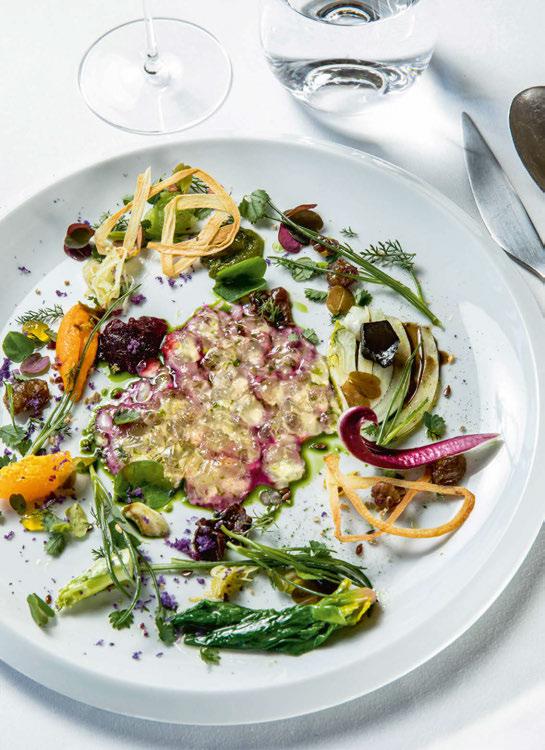
Service is another topic that Alléno is particularly passionate about, so much so that during the pandemic he wrote a book – Tout Doit Changer, translated as Everything Must Change – calling for a rethink in the way restaurants are run. He talks about training, working conditions and staff wellbeing, pointing out their impact on a smooth and efficient service. He laments the online booking system and lack of human interaction – “it’s a disaster!” – believing that a simple conversation in advance would allow for tailor-made menus, resulting in less waste and an altogether better experience – both in the kitchen and for the guest.
Putting the guest first is a sentiment that
Alléno returns to time and time again through our conversation. Even when I ask whether he aspires to get a Michelin star for Pavyllon London; he’s hopeful, of course, but states: “I work for my guests, not for stars.” As talk turns back to the London debut, the apprehension begins to show – this is clearly a launch that means a lot. “We have to be good,” he stresses. “I don’t want to disappoint the market and I don’t want to disappoint the hotel.”
Despite the pre-opening jitters, Alléno is confident in his offer and ready to make his mark on the London dining scene. As we come to the end of our call, I probe further on a signature dish in the hope that he might reveal more about Pavyllon London’s menu. “I know you have to ask that question to explain to your readers,” he laughs. “But I hate to speak about a signature dish – it puts me in a box, and I never want to be in a box. My signature is to make people happy through good food, good wine and good service.”


As President and Chief Operating Officer at Makeready, Christine Magrann has been tasked with leading the experience-driven group’s expansion across the US. Her extensive hospitality experience includes various F&B-focused leadership roles within the sector, including Assistant F&B Director for The Mansion On Turtle Creek and The Breakers Palm Beach. Since its inception, the Dallas-based operator has grown its portfolio to more than six hotels and 24 restaurants, bars and coffee shops, with more developments on the horizon for 2023 and 2024.

Upcoming Openings:
The Junto, Columbus (May 2023), Hotel San Carlos, Phoenix
As Makeready continues to expand its portfolio, the group’s President and Chief Operating Officer discusses placemaking, community connections and staying true to brand concept.
Words: Eleanor Howard
Established from the ground up to elevate independent hotels to a new level, Dallas-based experience-led operator Makeready is poised to take the US hospitality landscape by storm.
Founded by private investment firm Rockbridge in 2015, the self-proclaimed placemakers are on a mission to develop a carefully curated portfolio of independent hotels, restaurants and retail concepts that are completely different from one another yet all share a common purpose: to become an essential part of the community in which they sit, cultivating deep, emotional connections between hotel guests and locals, as well as in-house operations teams and the businesses with which they partner.
They do this by taking a decidely epicurean approach to development.“I think many guests today choose a hotel based on its food and beverage offering,” states Makeready President and Chief Operating Officer Christine Magrann. “They’re well-travelled, more sophisticated than ever and more exposed to the variety of options out there, so it’s critical that we create options that raise the bar.”
In plotting their growth, Makeready begin by assessing potential projects through the lens of a city’s culinary landscape. “We like to build a presence in cities that lean towards the foodie
community,” explains Magrann. “We look for places that already have a strong line-up of independent restaurateurs or where chefs have been able to thrive and make a name for themselves without the backing of big corporate brands. This gives us confidence that a city is ready for an independent lifestyle hotel and welcoming of restaurateurs who want to bring a unique experience to the site.”
What follows is comprehensive research, or homework as Magrann puts it: “We start with what I call the not-so-fun information. We pull a lot of the economic and demographic information to help ground us in the state of the city and community we’re going into. But where we spend a lot of our time is examining what is successful in the market, and asking where is there possibly a need for something new?” To do so, Magrann and team approach those who know the place best. “It’s meeting the bartenders and chefs within the city and understanding from their point of view what the city is looking for.”
While trendy food hotspots are a common thread running through the Makeready portfolio, this is where the similarities begin and end.
“Each one of our experiences has its own unique point of view – we don’t stamp out the same concept in multiple locations,” notes Magrann.
“It’s a harder way to do things but our overall philosophy focuses on being very intentional.”
In Dallas for example, The Adolphus’ F&B programme includes a Viennese café, while The Alida, a converted warehouse hotel in Savannah, Georgia, offers up coastal cuisine that celebrates the bounty of the Lowcounty at Rhett.

The process begins with the discovery of the heart and soul of each city and its people. “Our team will work with the owner to create a mood board of what we envision, and then we will work with a third party branding agency to help us bring it to life through the name, font, graphics and the story,” she says. “Once we create our concept, we lean into that brand identity, and make sure to keep asking ourselves how do we keep the integrity of our true north? One of the challenges in hospitality is sticking to your intentions, so keeping grounded in the roots of the concept is really important.”
Then it’s all about bringing the right people onboard – those who see their city’s true culture and can shine a light on it for others. “We hire chefs and general managers that are well connected,” explains Magrann. “We also invite other chefs to our tastings when we’re opening a new restaurant to get their feedback. A big part of our strategy is to become part of the F&B community, not competing with it. And in those markets, great restaurants recommend other
great restaurants, great bartenders recommend other great bartenders, so we really tap into this spirit that sets a stage for humbleness. And you have to be humble when you’re going into F&B because it’s hard to get right, so having this point of view and mindset has helped us to be successful.”
Listening to local voices during the development process effectively translates to filling tables. According to Magrann, Makeready seeks to achieve a 60:40 split between locals and inhouse guest covers. “The benchmark of local versus tourists is something we talk about a lot, how do we drive that? It’s a very important part of our strategy and is one of the hardest goals to accomplish.”
With Emeline’s woodburning concept Frannie & The Fox in Charleston for example, Makeready are already succeeding in this area. So how do they go about achieving this? “I think it comes with recognition and personalised interaction. How do we engage with the guest a little quicker because we see them tagging us on social media while they’re in the space with us? How do we foster that relationship and capitalise on it by making them feel special.”
So how does Makeready measure the success of a restaurant or bar? “Of course we also have
financial responsibilities, so achieving our monetary goals by year three – have we stabilised and gotten to the point we said we would when we first set up the concept?” reveals Magrann. “But a great mark of success is when we have other restaurateurs recommending us or coming to visit us and inviting us to their experiences. Just being beloved within the industry and within the community.”
Only time will tell with Makeready’s latest opening, The Junto in Columbus, but Magrann is confident they are onto a winner.“We knew that food in Columbus is a little more mainstream, it has an average price point, which is really important, and it has a great vibe to it. It’s a young, energetic, artistic city, so we leaned into those elements.” Billed as a ‘club for mutual improvement’ the opening marks the city’s first independent hotel, bringing a down-to-earth F&B programme with it. Guests and locals can expect a wood-hearth dining experience and an all-day neighbourhood coffee shop, but what Magrann is most looking forward to is the rooftop bar. “The Brass Eye rooftop experience is going to be really special,” she reveals. “It has near panoramic views of the city with great cocktails and a great beer programme. I’m excited about the playfulness of the concept because it has allowed us to be a little more free-spirited and create something that will have real longevity.”
Words: Cara Rogers
Photography: © Anas Rifai
Sleek, rustic and refined. This is the look 4Space envisioned for Jun’s, an AmericanAsian eatery in the heart of Dubai. Part of Vida’s hotel and residential development in the downtown district, the restaurant is the brainchild of chef Kelvin Cheung, in collaboration with UAE-based Three Layer Hospitality and Kings Group Ventures.
IN A BITE
Owner: Kelvin Cheung, Kings Group Ventures
Operator: Three Layer Hospitality
Interior Design: 4Space
Lighting Design: Huda Lighting
Main Contractor: Cube Wooden & Internal Design Accessories Industry
Chef: Kelvin Cheung
F&B Manager: Darryl Jèrome Fernandes www.junsdubai.com
“Our aim was to celebrate community and coming together; to create a place where guests can gather to celebrate the importance of life,” explains Firas Alsahin, co-founder and Design Director at 4Space. “The inspiration is drawn from horse stables, so we selected natural materials and interesting textures including timber and brick.”
At the rear of the restaurant, a seating area clad entirely in timber creates a cocooning effect, while a feature wall of pampas grass adds interest. Natural materials continue into the bar, where columns adorned with pebbledash sit alongside a bar counter carved from natural stone to resemble the jagged edges of a cliff.
More refined elements of the design can be seen in the bar’s marble top, copper detailing throughout and bold green Indian marble flooring underfoot. Drawing the eye, a series of installations made from i-Mesh – an intricate web of fibres – are suspended overhead in freeflowing ribbon forms, while organically-shaped pendants break down the volume of the doubleheight space. The main dining room features seating upholstered in rich copper tones, alongside cosy banquettes for group dining.
The cuisine is a harmonious blend of Asian and North American flavours – Cheung’s signature – with a menu featuring the likes of red hot chicken karaage and waffles, and wagyu tenderloin served with broccoli noodles. The restaurant also serves weekend brunch, cakes and a curated cocktail menu drawing on Asian flavours. Highlights include Umami Bomb, a concoction of miso bourbon, vermouth rosso and angostura bitters, as well as Ginger Chai Punch, which fuses a classic chai with ginger honey, citrus and rum.


Words: Megan Lenthall
Photography: © William Joshua Templeton
Dressed in velvet and leather with tasselled chandeliers and feather motifs, Penelope’s is a heady fusion of Israeli and Spanish flavours combined with a Berlin-meets-London sensibility. The signature restaurant at Hotel Amano, which opened in Covent Garden late last year, is overseen by Executive Chef Fezile Ozalgan and features a menu that is inspired by the chef’s own Turkish-Cypriot heritage, as well as her passion for barbecue.
with a choice of à la carte, set menus and pretheatre menus. Standout dishes include Paella Israeli-style with whole lobster; Freekeh and gin-tomato sauce; and pistou-stuffed courgette with piquillo cream, ajo blanco and tarragon oil. The star of the dessert menu is Penelope’s signature Baklava cheescake.
IN A BITE
Owner: Manex Properties
Operator: Amano
Architecture: Woods Bagot
Interior Design: Woods Bagot, Tala Studio
Head Chef: Fezile Ozalgan
F&B Manager: Babis Apostolidis
Bar Manager: Darko Doban www.penelopeslondon.com
Designed by Woods Bagot, interiors take cues from the style of the group’s sister properties in Berlin, adopting an eclectic look that comes to life with a flamboyant sense of theatre. Tactile fabrics, atmospheric lighting and mirrored ceilings combine with exuberant wallcoverings, while seating options range from raised platforms ideal for people-watching, to cosy corners and spacious booths.

The menu brings fresh flavours to the table with punchy dishes that see Ozalgan combine smoke and fire on the Mangal and Josper grills. Diners can expect an array of tapas-style dishes
In Berlin, Amano’s monthly parties have become something of a local phenomenon, selling out in minutes thanks to a combination of inventive cuisine and hands-in-the air, dancing-on-the-table freedom. With this idea in mind, the team has brought the same immersive concept to Covent Garden.
“Penelope’s is a real affair of the heart for me,” says Ariel Schiff, Amano’s co-founder. “Not only is it named after my daughter, both Spain and Tel Aviv hold a special place in my heart. We are bringing something completely new to London which is exciting – in Berlin we believe in having fun above anything else and we want to give Londoners and visitors to the city the same experience.”
A stylish touch to high-standard tables
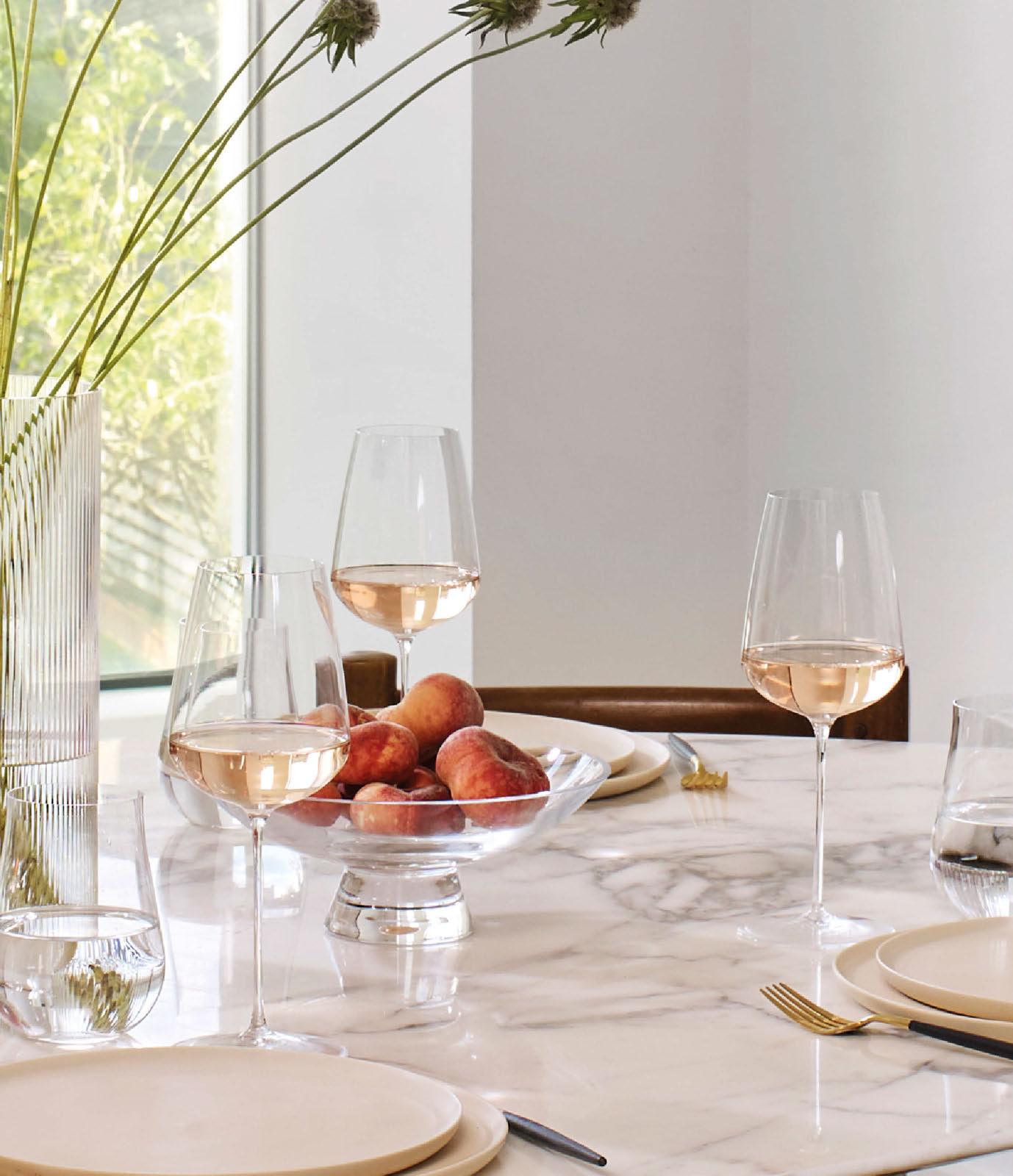
Words: Shanna McGoldrick
Photography: © Michael Kleinberg
New York’s Lower East Side is famed for its hi-low blend of gritty alleyways, bougie boutiques and finger-onthe-pulse nightlife spots that have secured its reputation as one of Manhattan’s most eclectic neighbourhoods. So when Moxy moved into town, it knew that a stylishly irreverent approach was the way to go.
IN A BITE
Owner: Lightstone
Operator: Marriott International, TAO Group Hospitality
Architecture: Stonehill Taylor
Interior Design: Michaelis Boyd
Executive Chef: Jason Hall
F&B Manager: Julian Werde and John Raiti
Beverage Manager: Erin Davey www.marriott.com
The result is Moxy Lower East Side, which features a dazzling interior by Michaelis Boyd and Rockwell Group, and a bold F&B programme developed by dining and nightlife operator Tao Group Hospitality in partnership with Lightstone. Inspired by the decadence that first put its Bowery location on the map, the hotel’s venues include Sake No Hana, a slinky Japanese restaurant; The Highlight Room, a glamorous rooftop bar; The Fix, an all-day café and lobby bar; and Loosie’s, a subterranean club accessed via a separate alleyway.
Amidst all this bewitching bluster, Silver Lining – a sensuous and sultry piano lounge –emerges as one of the most captivating spaces.
The dreamlike room was partly inspired by Andy Warhol’s seminal Silver Factory, and is designed to convey an important aspirational message. “Warhol famously called the Silver Factory his Studio of Hope,” says Fiorella Calvo, Project Designer at Michaelis Boyd. “His idea was to cover everything in foil and silver paint to create light and reflect on the activity happening within the studio. He felt that he could achieve hope and creativity, even in the darkest days.”
Michaelis Boyd began work on the venue with Tao Group Hospitality and Lightstone during the worst of the Covid pandemic, when New York was completely shut down. “We liked the idea of a dark space that had glimmers of hope – which is how we came up with the name Silver Lining,” explains Calvo.
With its velvet banquettes, glittering piano platform and dramatic backlit bar offering a curated cocktail menu of classic drinks, Silver Lining’s sophisticated brand of haute culture for the downtown crowd walks the line between optimism and finesse.


Atlantis The Palm DUBAI
Words: Eleanor Howard
Photography: © Alex Jeffries Photography Group
Atlantis The Royal may be creating a buzz following its star-studded grand opening earlier this year, but its sister resort Atlantis The Palm is keeping up with the competition by introducing new South American eatery, En Fuego, meaning ‘on fire’ in Spanish.
In creating the venue, Solutions Leisure Group partnered with Dubai-based Bishop Design to deliver a fiesta-style experience that captures the spirit and energy of Latin America. The result is a vibrant celebration of culture, cuisine and craftsmanship, with interiors characterised by a vast collection of artworks, artefacts and antiques that take guests on a sensorial journey through South America.
IN A BITE
Owner: Kerzner International
Operator: Atlantis, Solutions Leisure Group
Architecture and Interior Design: Bishop Design
Graphic Design & Menu Design:
Solutions Leisure Group
Executive Chef: Daniel Garcia
Head Bartender: Sandor Sigler Gonzalez www.atlantis.com
Upon arrival, diners are immediately immersed in a kaleidoscope of colour, where ornate pots and pedestals decorate a multicoloured walkway reminiscent of the cobbled streets of Colombia. From here, the venue flows into multiple highenergy spaces, from a bar centred around a fairground carousel to a lush tropical terrace for al fresco cocktails. A central rotund – complete
with a flamingo chandelier – dominates the main dining room amongst a visual feast of colour and pattern. The focal point however is the ceiling, layered with a vast array of curious items, ranging from vintage neon signs and tuk-tuks to piñatas and hammocks, with each piece bringing its own story, adding depth and character to the space.

Helmed by Columbian chef Daniel García, the menu celebrates Latin America’s culinary techniques and traditions through much-loved favourites such as Churrascaria grilled meats served with Peruvian yellow rice and roasted corn. There’s even an Avocado Altar in the style of a traditional sushi counter, showcasing different types of guacamole on offer.
As if the interiors and food weren’t enough to keep diners engaged, the restaurant is taking entertainment to new heights with the promise of fire performers, hoop artists, an energetic tango duo and gravity-defying aerial acrobats, as well as live music, meaning En Fuego is ready to set all the senses on fire.
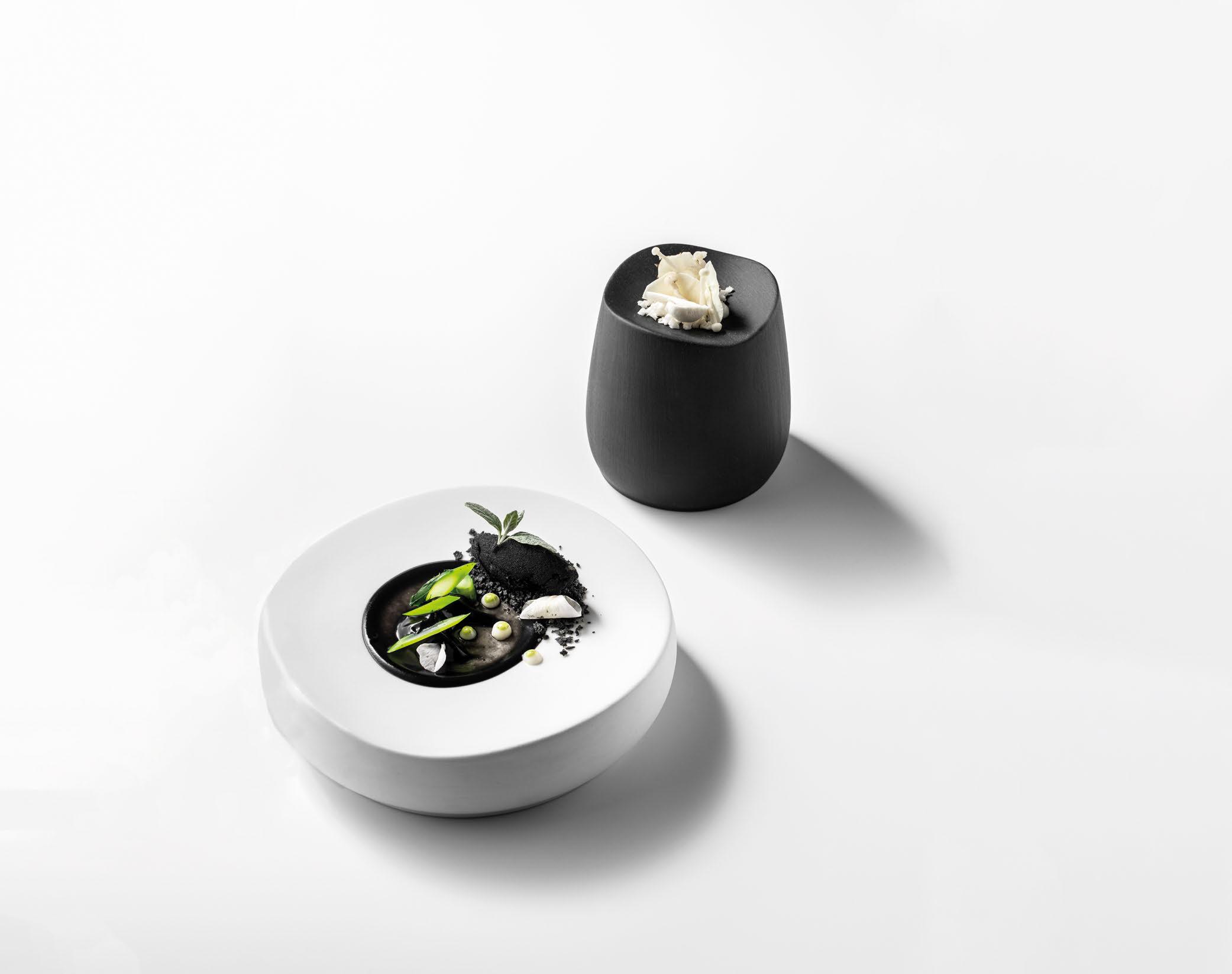
ASCOT
Dorchester Collection’s country house hotel unveils a new dining concept that pairs the best-of-British with an autumnal design scheme.
When Coworth Park set out to revamp its flagship restaurant, the aim was to come up with a concept that is both entirely individual and complements the surrounding Berkshire countryside. It was a brief that was put to both chef and designer, and together they have created Woven, a restaurant that sees the stories of people, place and produce woven into every aspect of the experience.
With Executive Chef Adam Smith’s name now above the door, the cuisine is a showcase for best-of-British ingredients, while interiors by Martin Hulbert Design –the studio behind the hotel’s original refurb in 2010 – puts nature centre stage.
For Smith, who began his professional career aged 19 working in one of London’s most iconic hotels, the new venture was an opportunity to rethink his own culinary style.
“I knew that with the next step in my career, I wanted to create something very personal,” he explains. “I spent 10 years at The Ritz and loved it, but my cooking style has evolved since then through different experiences.”
This idea of creating something that is personal to Smith inspired the restaurant’s moniker, as he explains: “The name Woven comes from taking the best bits from everything we as a team have done.” To this end, every aspect of the concept, from the menus to the design, is threaded together
to create a dining experience that is unique to both the chef and the location.
On the table, dishes present traditional flavours and techniques in fresh, modern ways using ethically farmed, caught and grown produce from across the UK, combined with ingredients from the hotel’s kitchen garden. “We source the best-of-British when we can,” Smith reveals. “Fish is served the same day it’s caught from Cornwall and I source cheese from Henley-on-Thames. Some of our beef is Irish and some is from North Yorkshire. Our venison is wild shot and our rhubarb comes from a farmer outside Bradford.”
Smith’s emphasis on ethically farmed produce ties in with the restaurant’s dedication to sustainability, which is also visible in elements of the interiors through the use of recycled materials. The beverage list, too, spotlights national and regional favourites, with cocktails highlighting locally grown ingredients and the sommelier paying particular attention to still and sparkling English wines.
The dinner menu kicks off with a ‘From the Pantry’ section in which a selection of classic British dishes have been reimagined as creative hors d’oeuvres, such as coronation chicken and minted lamb salad. These are followed by ‘From the Larder’ and ‘From the Stove’ courses – the header giving a clue as to the style of the dish. The menu closes with ‘From

In creating his dishes, Smith uses ethically farmed, caught and grown produce from across the UK, alongside ingredients from the hotel’s own kitchen garden

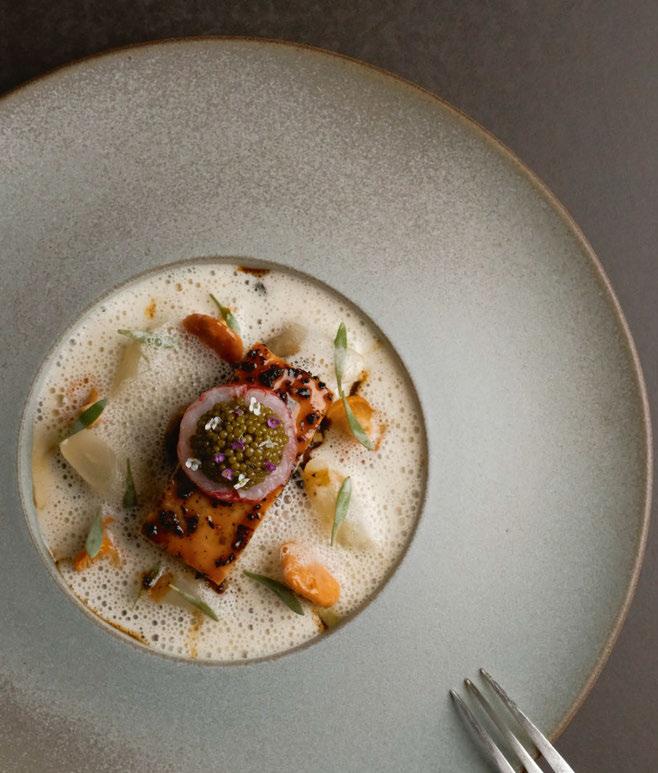
the Pastry’ dessert options, and final ‘Treats’ comprising a selection of petits fours. So what has been popular so far? “There’s a jellied eel dish that people often wouldn’t choose off a menu but once they try it, they love it,” discloses Smith, noting that the set menu-style of the hors d’oeuvres is designed to take diners out of their comfort zone. “The Turbot Jubilee main course is also becoming a signature; I’ve had people come back three or four times for that dish already. We cover Cornish turbot in a lobster truffle mousse, poach it and serve it with two sauces – for one we use the lobster head to make a truffle lobster jus and for the other we make a classic champagne sauce, which is something I cooked when I won the Roux Scholarship. People really like it and I enjoy cooking it.”
Upon entering the restaurant through a new pantry and wine room, guests are greeted by a set of garden sculptures made by Marcus Crane and Dan Ainsworth using recycled materials. The space opens up to a 44-cover dining room with natural daylight flooding through floorto-ceiling windows, while a conservatory-style private dining room dressed with rows of potted
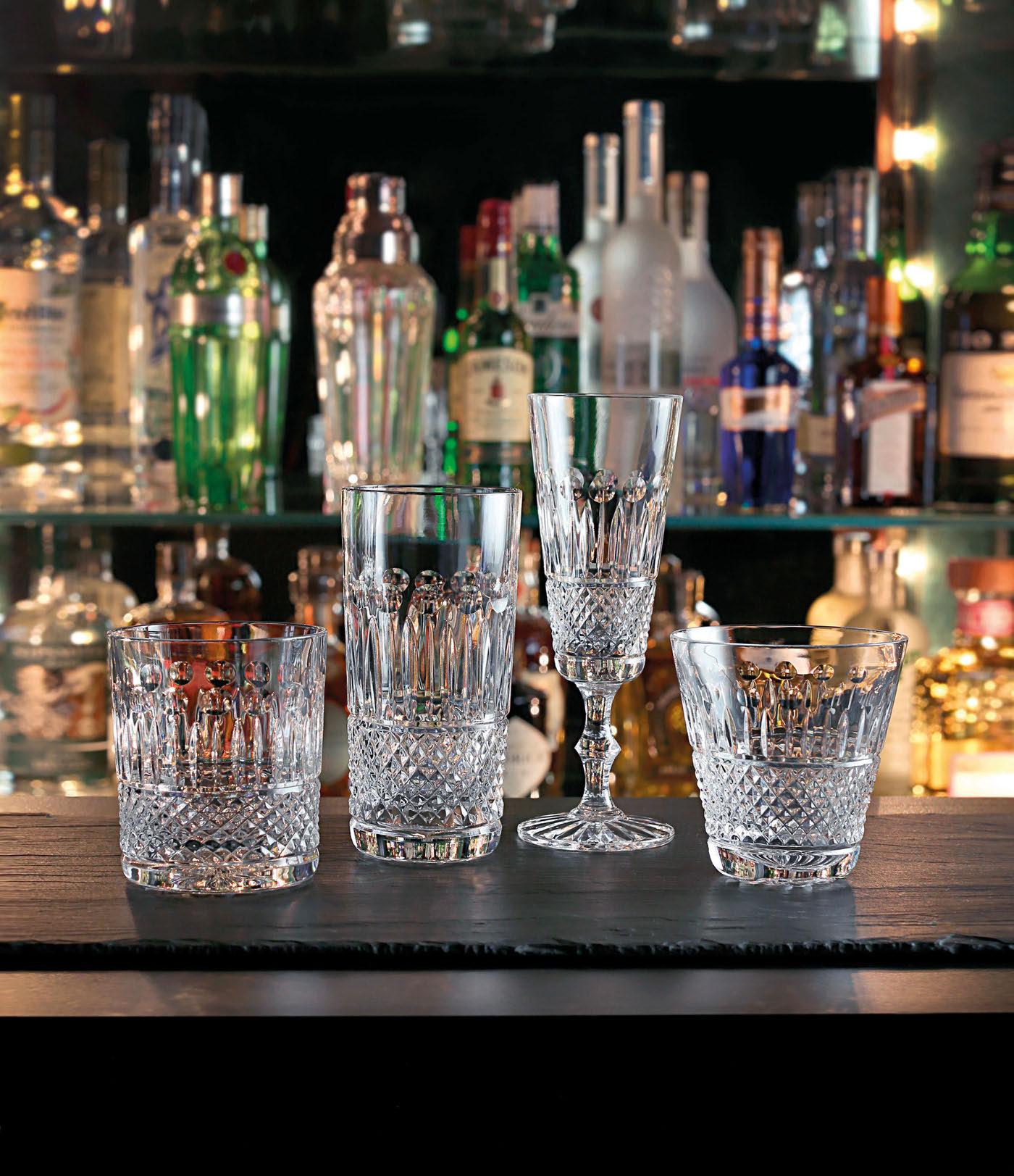
plants complements the greenery just outside. In fact, every aspect of the design, from the colours and textures to the use of lighting, is inspired by nature, with different spaces characterised by changing seasons. Autumn for example is showcased through a warm earthy colour palette in the main dining room, where a bespoke ceiling installation designed by Martin Hulbert in collaboration with Umut Yama represents a forest canopy and the way light filters through the leaves.
Mounted on the back wall, a plaque created by Locker & Riley – artisans in plaster – is set with root vegetables and serves as a centrepiece, while linen wallcoverings bear a hand-drawn oak leaf motif. The influence of the natural world can also be seen in the waiter stations, which are made from papier mâché and resin, yet appear as tree trunks taking root.
Colourways are distinctly autumnal, with banquette seating upholstered in teddy mohair featured alongside dining chairs by Poltrona Frau – their leather in a warming tone of autumn
leaves. Corded screens provide an element of privacy between the tables, while pendant lighting sparkles up above come nightfall.

The detail on the tabletop has been considered too, with handmade plates and cutlery selected to complement the experience. Some are vintage, while others have been sourced from makers such as Goodfellows, Craster, John Jenkins and Serax. Centrepieces including ferns, thistles or conkers – depending on the season –tie-in to the overarching scheme, and it’s this cohesion that creates a distinct character.
“The best restaurants are the ones with a strong identity,” concludes Smith. “At Woven, the identity comes from the personality and style of food, but also the style of the interiors. One of the nicest things about how well Woven has been received is that the people who loved the hotel’s restaurant before, love it even more now. There’s no better feeling than when you surpass someone’s expectations and surprise them. You feel it in the whole atmosphere of the room.”
Operator: Dorchester Collection
Interior Design: Martin Hulbert Design
Graphic Design: Magpie Studio
Lighting Design: DPA Lighting
Executive Chef: Adam Smith
F&B Director: Jonathan Ellson
Head Sommelier: Sandro Mezzapelle
Dinnerware: Goodfellows
Serveware: Craster
Glassware & Barware: John Jenkins
Cutlery: Zoë by Ann Demeulemeester for Serax
www.dorchestercollection.com

OSLO
Combining Norwegian produce with innovative and experimental techniques, Chef Andrea Selvaggini serves up a feast that knows no boundaries.
Sometimes I wake up in the middle of the night with an idea, so I write it down immediately. That’s how I came up with the carbonara doughnut dish,” explains Andrea Selvaggini, Executive Chef at Savage at Revier in Oslo. Hailing from the coastal city of Tarquinia in Lazio, midway between Rome and the Tuscan boarder, Selvaggini always knew he wanted to be a chef. Contrary to his parents’ wishes, he worked odd summer jobs to pay for a threemonth cooking course before embarking on a six-month internship that took him around Italy. Armed with a passion for the profession and a zest for travelling, off he went to work in the kitchens of France, Luxembourg, Spain, Mexico and finally, Norway.
“The first place that really changed my life as a chef was Metamorfosi in Rome under chef Roy Caceres,” admits Selvaggini. “I loved the style and the creativity, which at the time was just mind-blowing.” His curiosity for
molecular gastronomy was further developed working for chef Quique Dacosta in Spain, whose food has always been highly influenced by architecture and art. It was Selvaggini’s next stint at Quintonil in Mexico under chef Jorge Vallejo that, interestingly, spiked his curiosity for Nordic cuisine. “We did a lot of four-hands dinners with top restaurants from around the world at Quintonil. The collaboration with Maaemo from Oslo was unforgettable – the food was so clean and beautiful. So, I decided to leave the sunshine behind and move to the deep cold,” recounts the chef. Working both as a sous chef and in research and development at the Nordic powerhouse Maaemo – which currently holds three Michelin stars – gave Selvaggini enough culinary ammunition to craft his own style at the newly opened boutique hotel Revier, and its flagship restaurant Savage. Located in the neighbourhood of Kvadraturen in central Oslo, Revier is a 65-key hotel that
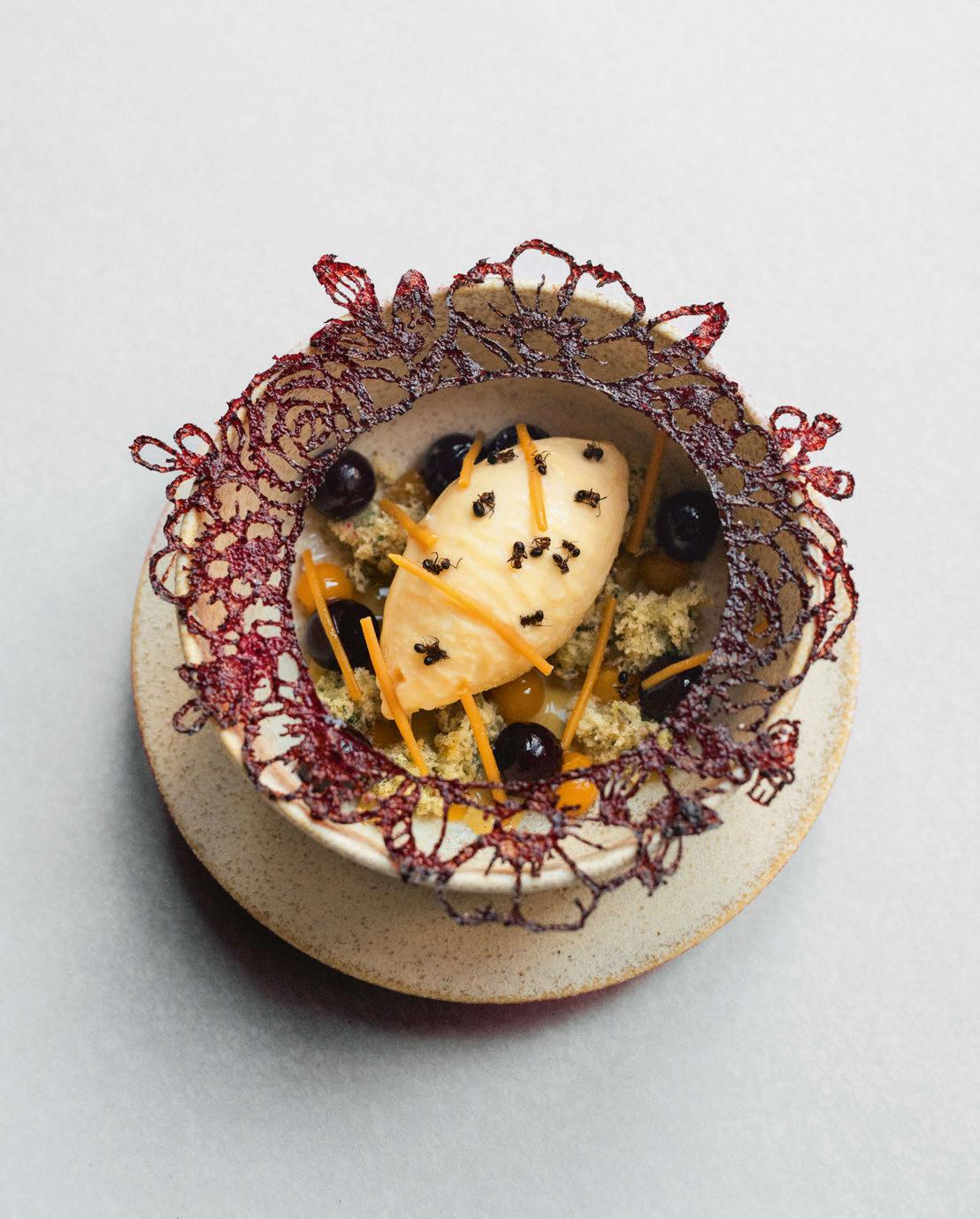
The Sunflower (above) pays homage to The Green Room’s original function as a florist, while the lobster claw (opposite) is a celebration of langoustines

seeks to facilitate encounters among the capital’s residents and visitors. “For us, it is about bringing people together and breaking down cultural boundaries,” explains Emil Tingulstad, co-founder and Chairman of Att, the operator of the hotel. Upon entry, there’s no lobby; instead guests walk into Bar Revier, an open space that changes use through the course of the day, serving à la carte breakfast and weekend brunch by morning, before becoming a fully-fledged cocktail and wine bar by night. Handcrafted pasta is made next door in the open kitchen of Null Null – the more casual of the two restaurants on site – while the basement is home to a small cinema with its own compelling food and drink experience. The final element of the F&B offer, a roof terrace called Over Revier, will open later in the spring, adding another reason to visit the property.
Ultimately, it’s Savage that takes centre stage as the hotel’s gastronomic highlight, showcasing the eclectic nature of the Nordic capital through a culinary lens. The name Savage brings chef
Selvaggini back to his early years. “Friends used to call me ‘little savage’ when I was a kid, and I was a bit wild as a teenager,” he admits. “Plus, I think the kitchen is a savage place to work.” However the name here alludes to the process rather than the experience – there’s nothing savage about the calming ambience or beautifully presented dishes. The tasting menu journey begins in the Flower Room, a dimlylit space enclosed by a variety of plantlife. Aligning with the aim to facilitate encounters, all guests sit at a single table and get acquainted as the first snacks are brought out. The chef’s signature bite, The Sunflower, is a potato crisp shaped as a sunflower with oyster emulsion, champagne jelly and caviar – bold and opulent ingredients presented in a very delicate and minimalist way. The experience then moves into the main dining room, tastefully designed by Hanne Gathe and Linda Gram Egede-Nissen of Gathe + Gram, with Constance Tenvik’s artwork completing the look.
Guests can choose between two tasting

menus – the full Panorama or the smaller Perspective. “The decision to have more than one menu is twofold – it helps us operationally and it makes us more accessible to a wider audience. Depending on the occasion, you can visit us multiple times not just for one special meal,” explains Selvaggini. There are also seats at the long central bar for walk-ins and those opting for the shorter tasting. Sitting bar-side brings the guests closer to the action, peeking into the kitchen and allowing for chats with team members who flit between plating and serving. “I don’t want stiff service or anything too formal, we are a very welcoming place,” stresses the chef.
The ingredients on the menu change according to what the farmers, fishermen and other suppliers have available. Since opening in October, countless dishes have been introduced or amended, but some of the stars will stay, the langoustine claw being one of them. “Everyone always wants to use the biggest langoustines, I wanted to use all the others in a single dish,
so we created a mousse, shaped it in a lobster claw mould and served it with creamy haddock and nduja butter on the side.”

The level of creativity continues through to the dessert course and petits fours, which elegantly round out the dining experience. The humble ricotta was turned into a masterful centrepiece, carefully wrapped in thin pear shavings, and surrounded by bitter dark chocolate sauce, creating a perfect harmony of texture and taste.
Chef Selvaggini and his team are just getting started on what Savage is to become – a breeding ground for culinary creativity that uses the best of Norwegian produce, but flavour-wise knows no borders. There aren’t many hotels with a designated space for research and development, but at Revier, it is all about innovation and community. “I want to encourage fresh ideas from the whole team, everyone should be involved in the creative process. That way, they feel part of the restaurant’s journey,” stresses Selvaggini. “Work as you own it!” Words to live by, chef.
Owner: Oro
Operator: Att
Interior Design: Gathe + Gram
Graphic Design: Feed & Smuss
Executive Chef: Andrea Selvaggini
General Manager:
Jaime Lindquist-Docherty
Head Sommelier:
Cecilie Bundgaard-Larsen
Catering Equipment: La Marzocco www.revier.no
Since 1924, Eternum has been an internationally recognised player in the world of stainless steel cutlery for the hospitality, with a presence in over 70 countries.
Steak knives Ornô - 5Cr15MoV steel - ABS, Walnut or Olivewood handle.

Visit us at NRA Chicago.
Eternum - Belgium since 1924 - www.eternum.com - export@eternum.com
DOHA
Raffles Doha provides the immersive backdrop to the craft of three-Michelin-starred Enrico Crippa, whose famed mastery of the vegetable takes root in his first venture outside Italy.
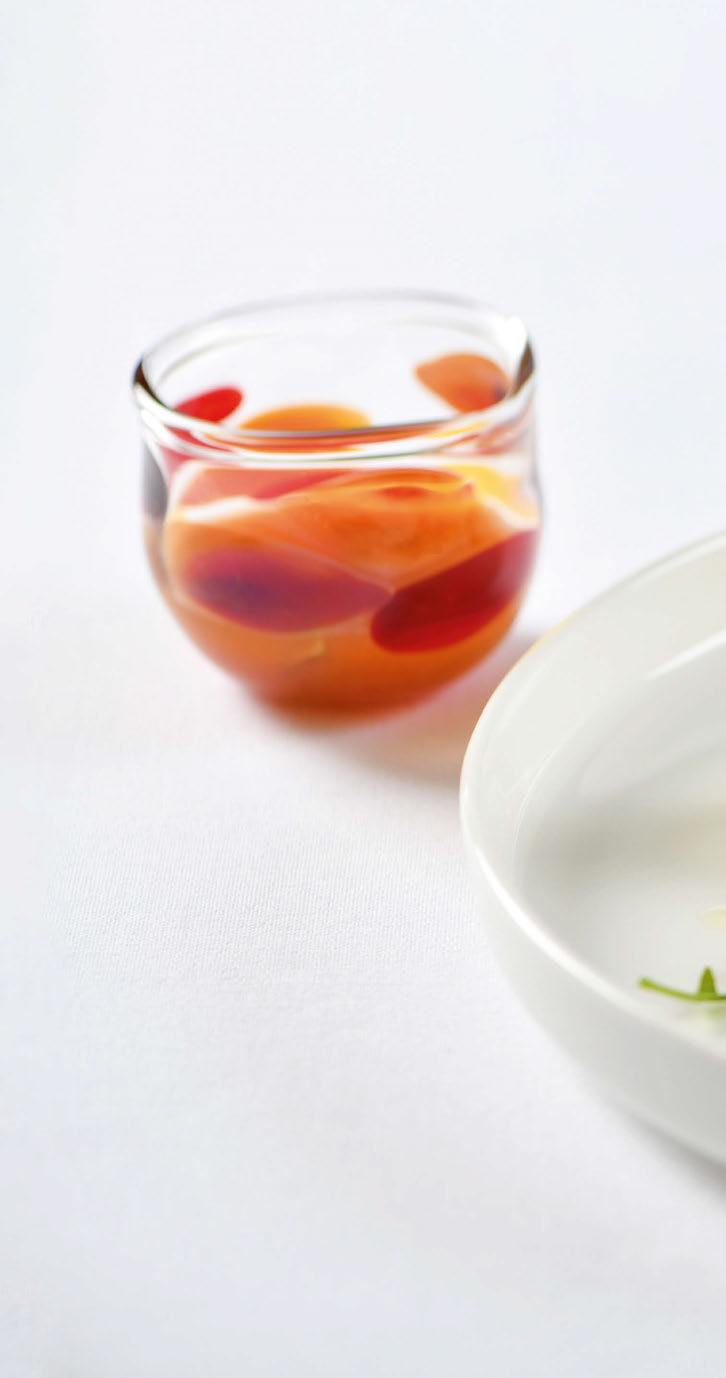
Without having to leave the opulent confines of Doha’s iconic Katara Towers, it is possible to take a culinary world tour, sampling plates large and small across ten restaurants and lounges that serve the cuisines of Latin America, the Middle East and Asia as well as the confections of Paris. Spanning the sister properties of Raffles and Fairmont Doha, the sum is hotel food and drink at its most confident, catering for every taste bud, palate and craving, but leaving space for theatrical storytelling to elevate venues to another level.
With its laser focus on technicality and craftsmanship, Raffles Doha has turned to an intriguing Italian chef for one of its destination-dining offers. Rather than relying on industry luminaries whose names already hang over restaurant doors in the region, Raffles has chosen to collaborate with a chef who has cultivated his reputation by taking humble vegetables and transforming them into the heart of a gastronomy that celebrates the terroir and produce of Piedmont – a north Italian region known for the delicate white truffle. Piazza Duomo, riding high in the World’s 50 Best, was opened in Alba back in 2005 through a partnership between Enrico Crippa and the winemaking Ceretto family. Within a year, Chef Crippa had been awarded a Michelin star, and by 2012 it was three. Since then, the enigmatic chef has been hesitant to repeat the experience anywhere else in the world, until now.




“When we first started with our garden in Italy, we were pioneers for sure,” recalls Crippa. “During those years of experimentation, we discovered we could treat vegetables in the same way we prepare protein or pasta. There are hundreds of preparations that work well to extract the best taste from vegetables so we want to guide guests on a different journey into this green world.”
The Qatari capital’s spirit of growth and openness to the new particularly appealed to Crippa, who is seeking to replicate “a real Italian experience in terms of food and hospitality”. To that end, Alba by Enrico Crippa is helmed by five senior staff from Piazza Duomo including Executive Chef Antonino D’Alessio, Sous Chef Gioele D’Amici and General Manager Vincenzo Donatiello, all of whom have relocated to Qatar. D’Alessio spent four years working with Crippa in Italy, including an intense twelve months before the opening of Raffles to finalise the food concept. “His eyes are my eyes in Doha,” Crippa confirms.
The prominence of the vegetable remains integral to Alba’s menu, although there is also an accommodation of regional Middle East produce. “We have worked on a menu that displays the best of our kitchen concept and of Italy’s culinary history, mixing this approach with ingredients we can find locally,” says Crippa. “We haven’t exactly altered the menu for the local market, but we have catered to Qatari guests and their habits. It’s also been a nice surprise to see the presence of farmers and farmers’ markets there as well as what they cultivate.”
To set the right scene for Alba, design consultant Dar AlHandasah, working with Marcel Wanders Studio, has created a journey of textural landscapes, drawing on raw materials, striated marble, polished stone and timber flooring to take guests through a collection of unfolding spaces. From Murano-inspired handblown glass vases that greet diners
upon arrival to an onyx and backlit amber bar through to banquette seating in the main dining room, finished with theatrical drapery, Alba speaks of Italian refinement. The arched murals that enliven walls take a moment to reference the meeting of two cultures, with Italian ceramic decorative patterns combining with Islamic motifs. VIP seating in the main area comprises an opera-style Romeo and Juliet balcony, while the private dining room mirrors the atmosphere of a vaulted cave. A brickwork-paved food library replete with full-height shelving, accessed by a ladder, includes humidors protecting the precious truffles that feature on the menu, while the tiled and timber wine cellar is adorned with artfully opened caskets from the Cerreto family’s vineyards in the Langhe wine region. After dining, guests can complete their experience by buying Alba-branded pasta, nougat, truffle products and signature hazelnut cake from Piedmont.
Enhancing the Italian atmosphere are specially designed uniforms, worn stylishly by Chef D’Alessio and his crew. Taking advantage of the view from the Chef’s Table positioned in the Molteni-equipped kitchen, it’s clear to see that D’Alessio is in total command despite his relatively young age, his insouciance bringing to mind classic Italian movies. While his sous chefs buzz around him, he leans nonchalantly, raising an eyebrow here and there to indicate satisfaction before stepping in for final flourishes and plating.
For the tasting menu, there’s a series of Italian antipasti served together, including a delectable pizza bread topped with white truffle and burrata, a play on caponata, slowbraised veal and a melt-in-the-mouth rice crisp flavoured with powders that bring to mind the Italian flag. The fried rigatoni is a particular delight. Supper is lucky to have caught the end of the short white truffle season, but the restaurant team will soon turn to black summer and winter varieties to extend the ingredient’s presence on the menu. A stunning
Doha leaf salad follows, this course in particular gently incorporating local ingredients including chickpea flour, dates and pistachio. To augment the eating of the leafy varietals, Crippa has developed tweezers imprinted with his signature with which to consume the salad. Designed by Massimo Lunardon, the plate features hues reminiscent of the desert landscape.
Accepting the recommendation of the sommelier, accompanying wines come from the Ceretto family’s label and are poured into Zwiesel Glas pieces. A Monsordo is served with the next course of king crab, bisque, burrata cream, rucola and beluga caviar. Before moving on to the next plate of satisfyingly minimalist Cacio e pepe – the pasta cooked up close by D’Alessio – there’s a chance to handle some white truffle wearing a glove. The price and provenance of the rare ingredient are discussed before D’Alessio explains that he and Crippa have enjoyed considering how to please local palates; for example, they have experimented by deriving aromatic flavours from spices
and herbs in the traditional place of wine. A colourful injection of saffron risotto arrives next, paired with an elegant preparation of osso bucco and a knockout Barolo before the final savoury plate, one that D’Alessio is particularly proud of. Courgette is the star here, served in the scapece style and shaped like the scales of a fish to complement the neighbouring seabass. In this dish, Chef Crippa has allowed a nod to his Executive Chef’s southern Italian roots.
The final flourishes are the lightest of lemon cakes, the citrusy taste drawn out by an accompanying glass of Moscato d’Asti, and then nougat rich with Piedmontese hazelnuts, which is chipped away playfully from a sizeable block with tools before being presented on a pretty plate. Soft, chewy yet perfectly balanced, it’s a mouthwatering treat to end the meal.
Italian cuisine has a reassuring popularity in Doha – by turning to Chef Crippa’s inventive artistry, Raffles Doha is sure to successfully differentiate itself from the competition hotting up in the city’s flourishing culinary scene.

Owner / Developer: Katara Hospitality
Operator: Accor
Architecture: Kling Consultants, Dar Al-Handasah Shair
Interior Design: Marcel Wanders Studio
Executive Chef: Antonino D’Allesio
General Manager: Vincenzo Donatiello
Head Sommelier: Paula Miguelina Manon Dajer
Glassware: Zwiesel Glas www.thereveriesaigon.com
zwiesel-glas.com

The

new Fusion.
two together makes one of a kind

23 world-class chefs descend on Lancashire to showcase their skills at Northcote’s annual culinary festival.
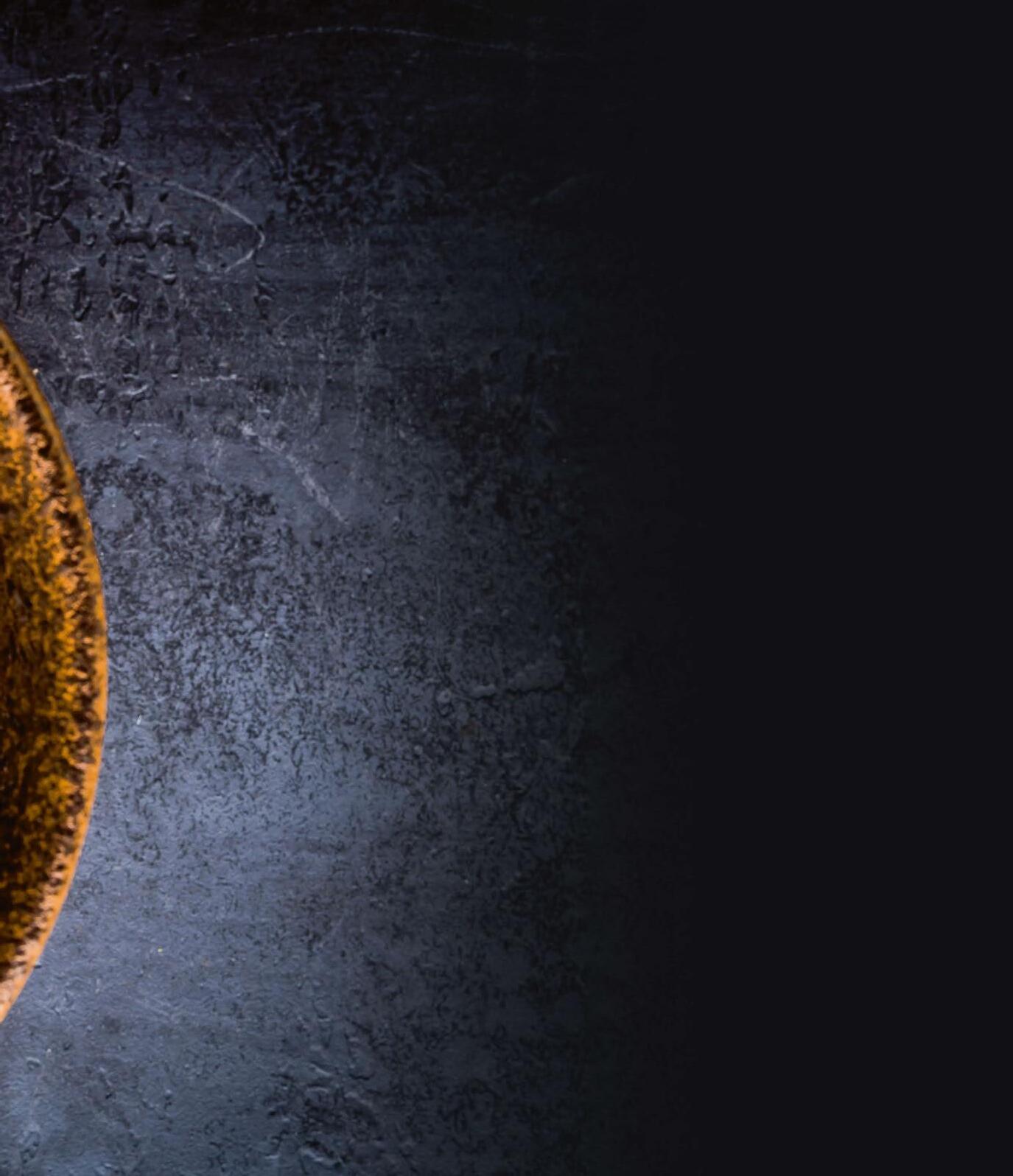
Every year in the depths of winter, an unassuming country house in the north-west of England becomes the unlikely setting for a culinary festival, which, since its launch in 2001, has built quite the reputation for its world-class line-up and stand-out cuisine. Inviting both well-established and emerging chefs to cook across 17 consecutive nights, Obsession is now a highlight of the culinary calendar, selling-out months in advance in what is typically a low revenuegenerating time for hospitality.
Taking place at Northcote – a Stafford Collection hotel nestled in Lancashire’s Ribble Valley – the venture is led by the hotel’s Managing Director Craig Bancroft together with Executive Chef Lisa Goodwin-Allen. Their aim? Simply to offer a memorable dining experience. The 2023 edition undoubtedly delivered, with the stellar line-up of talent showcasing their skills across five-course tasting menus created exclusively for the event. Chet Sharma of Bibi, Valentine Warner of Holmen Lofoten and Tom Sellers and Tom Phillips of Restaurant Story were amongst this year’s guest chefs, as well as leading names from various hotel restaurants. Goodwin-Allen also took to the stoves, collaborating with Niall Keating of Lunar on the opening night, and closing the event in an all-female extravaganza with Monica Galetti of Mere and Nieves Barragán Mohacho of Sabor.
Across the festival, chefs were given free rein to be creative, enabling them to source ingredients from preferred suppliers and bring their own flair to the flavours and finish. With this in mind, the festival is often a good indicator of current culinary trends, and 2023 was no exception. Seafood was a real focus with an abundance of turbot and scallop dishes, while desserts with savoury notes were also popular, a pairing challenge for the sommelier team, which they duly rose to.
In all, Obsession 23 played host to 23 worldclass chefs – counting an impressive 15 Michelin stars between them – with 97 different dishes served to 1,800 diners. And though fine dining and Louis Roederer Champagne were on the menu, the event also has a philanthropic ingredient, raising funds through nightly auctions. “It has been a tough time for the hospitality industry, we were just starting to recover but now business is being affected by so many other factors,” concludes Goodwin-Allen. “To support people by raising over £70,000 for Hospitality Action is amazing. I’d like to thank the team and the incredible line-up of chefs who came to Northcote to help us to achieve that figure.”
See overleaf for Supper’s pick of Obsession 23 highlights, focusing on the chefs operating within a hotel.
Flying in from Porto, where he heads up the two-Michelin-starred restaurant at The Yeatman, Ricardo Costa brought his passion for fresh seafood to the fore, serving blue lobster, smoked eel and codfish. Best known for combining traditional Portuguese flavours with innovative techniques and contemporary flair, the chef has long been on the wish-list to participate in Obsession. For his debut, a highlight was the opening course of tuna, served with yoghurt and foie gras.
Hailing from Yorkshire, Tommy Banks is chef patron of The Black Swan, a Michelinstarred restaurant-with-rooms in Oldstead. Championing a field-to-fork ethos, his approach centres around seasonal produce, which the team grows, rears and forages for themselves. For his Northcote residency, Banks put meat centre stage, beginning with a hearty bowl of seven-year-old Dexter beef served with Stichelton and Birch polypore, followed by a prime cut of fallow deer plated with crapaudine beetroot cooked in beef fat alongside red cabbage and chicory.



Based at Da Terra – the two-Michelin-starred restaurant at London’s Town Hall Hotel –Brazilian-Italian chef Rafael Cagali introduced his experimental cuisine to Northcote, pushing boundaries with flavour combinations and presentation. The picture-perfect Isle of Mull scallop was presented on a bed of seashells, while the chef honoured his heritage by dressing wild turbot in a moqueca sauce. This was followed by Longhorn short rib served with sweetbreads, kale and a vibrant salad.
Bringing his brigade from Jöro, a restaurantwith-rooms in Sheffield, Luke French served a fresh and vibrant five-course menu accompanied by wine pairing selected by the Northcote team. The North Sea cod was bathed in a zesty wasabi and lemongrass velouté, while the Orkney scallop was topped with a verdant salty finger salad. A highlight was the opening course of Chawanmushi, a savoury egg custard dish from Japan, served here with moules marinières, sake and yuzu brined trout roe.
Having recently been appointed Chef Patron at Farlam Hall, a country house hotel in Cumbria, Hrishikesh Desai returned to the Obsession line-up for a second consecutive year, bringing some unexpected flavour combinations to the plate. The Skrei cod and spider crab for example, was served in a Indian sambar emulsion, while the Cumbrian Beef ‘Wellington’ got a kick from the Tandoori gravy. A vegetarian dish of cauliflower ‘moilee’ topped with puffed rice salad also proved popular, showcasing Desai’s passion for his Indian heritage.



Making his Obsession debut, Swedish chef Alex Nietosvuori heads up Hjem, a restaurant-withrooms in Hexham, which gained a Michelin star in 2021. Combining Northumbrian produce with Scandinavian values and cooking techniques, Nietosvuori’s menu comprised scallop with celeriac and chanterelles, followed by a cod dish dressed with razor clam, walnut oil and pine nuts. A highlight was the trout, served with a generous drizzle of coulis.
Having worked alongside Alain Ducasse and Hélène Darroze, Alex Dilling opened at London’s Hotel Café Royal last September, marking his first eponymous restaurant. At Obsession, he introduced diners to signature dishes such as paté de campagne and Hunter-style chicken, showcasing his modern take on traditional French cuisine. Dilling also demonstrated his love for caviar, serving aged Kaluga Caviar with Scottish langoustine and ginger, topped with a buttermilk ‘bavarois’.
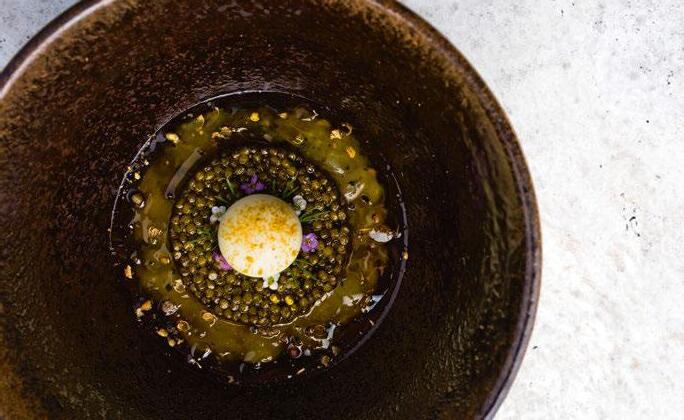
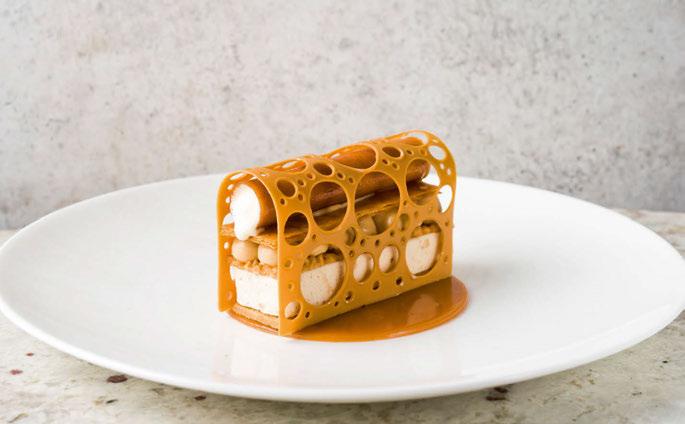
Bringing their Michelin-starred cuisine from The Ritz in London, Executive Chef John Williams and Head Chef Spencer Metzger took over the kitchen at Northcote to recreate highlights from their seasonal Epicurean menus. A ballotine of duck liver was served with dollops of damson and pistachio, followed by Cornish turbot in Veronique and garnished with grapes. Succulent Bresse pigeon was layered in a shapely pithivier, but perhaps the most eyecatching was the dessert, a salted peanut parfait encased in a delicate fudge and dulcey shell.

As a double billing, Sally Abé of The Pem and Anna Haugh of Myrtle Restaurant joined forces to create a menu that celebrates produce from across the British Isles. Haugh, who has recently opened a new restaurant at Conrad Dublin, served an opening course of Gubbeen mousse on a bed of Jerusalem artichoke, toasted pecan and field mushroom, followed by a main of Irish beef with boxty in a confit shallot sauce. Bringing her best-of-British ethos from The Pem – located within Conrad London St James –Abé served a perfectly-plated poached Scottish langoustine with stuffed Savoy cabbage, lardo and shellfish consommé.
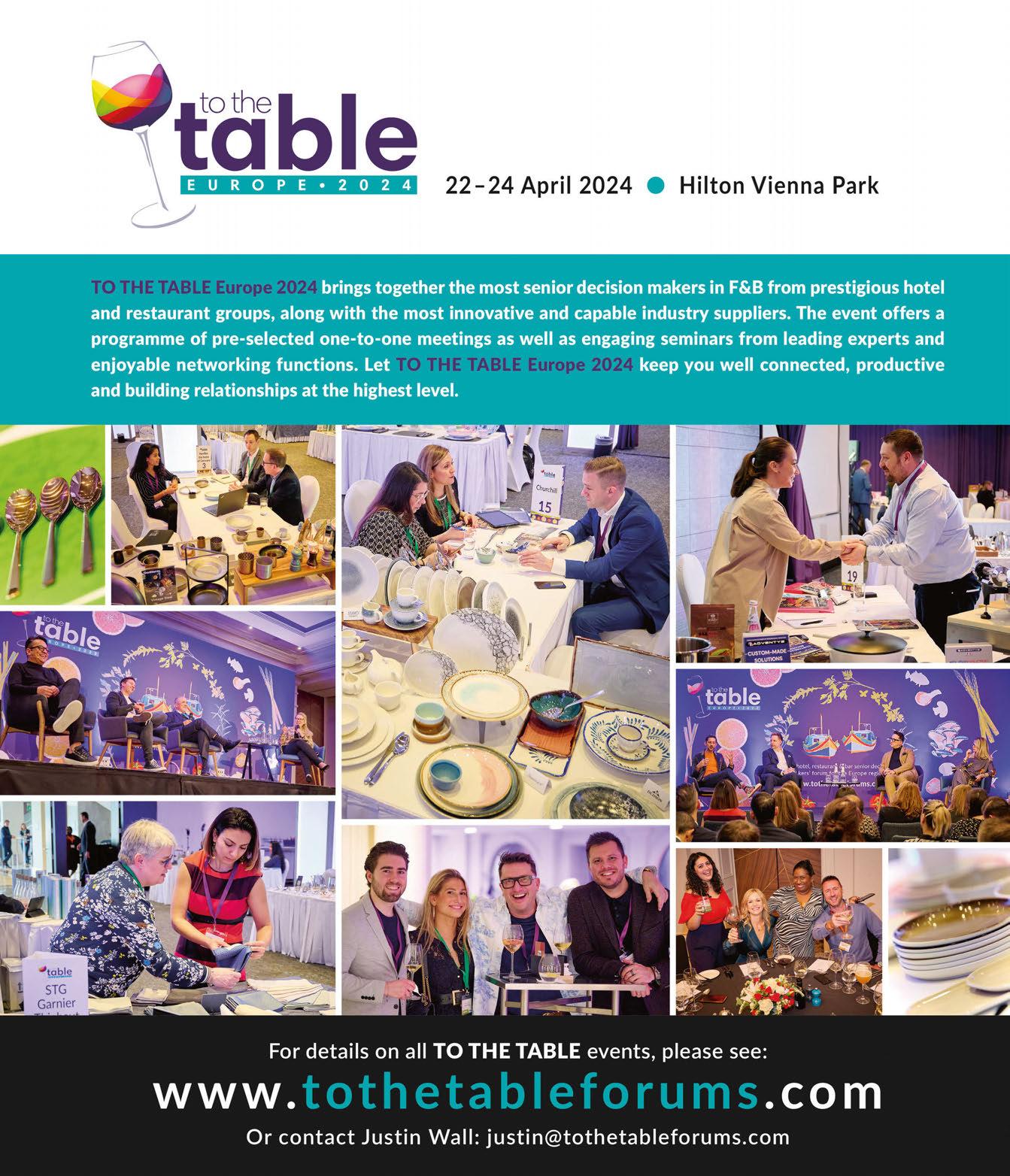

Ennismore’s integrated F&B studio Carte Blanched is reimagining the bespoke drinking and dining development process, with impressive results.
Life at Ennismore moves at breakneck speed. “Lifestyle is the fastestgrowing sector in the hotel world right now – it’s exploding,” says Alex Ghalleb, Global Vice President of F&B Development (Operations) at the London-based company, whose global portfolio spans more than 100 hotels across a multitude of forward-thinking brands including The Hoxton, Mondrian and SLS.
Ghalleb is one-third of the leadership team at Carte Blanched, a fully integrated food and beverage studio that Ennismore founder and co-CEO Sharan Pasricha believes represents “a completely new and unique approach to how we deliver extraordinary drinking and dining destinations.” Pooling the company’s in-house resources, the studio provides hotel owners with the kind of innovative, bespoke culinary experiences that have made Ennismore – now majority-owned by Accor – one of the fastestgrowing groups in the lifestyle sector. Its services span from strategic development and market
research through to brand creation, training, marketing and PR. It collates an extensive network of chefs, mixologists, creatives and operators who bring individual F&B venues to life on a project-by-project basis, overseeing every single phase from concept to completion and beyond. Joining Ghalleb at the helm of this visionary venture are Wayne Brown, Global Vice President of F&B Development (Culinary), and Jules Pearson, Global Vice President of F&B Development (Creative).
Since its inception in 2021, Carte Blanched has opened more than 17 outlets across Europe and the Middle East, kicking things off with the launch of Tandoor Tina, a contemporary Indian concept set within 25hours Hotel Dubai, which focuses on live fire cooking and charcoal tandoor techniques. “We found a great chef partner, Trisha Henault; she’s a French-trained Indian chef with an incredible personality and she really brings the concept to life,” explains Brown. “She really captures what Tandoor Tina is about.”
Tailored, effective partnerships are a fundamental contributor to the studio’s success rate, and the notion of sourcing, nurturing and showcasing international talent lies at the core of its ethos. “Following the pandemic, the hospitality industry continues to face challenges,” elaborates Pearson. “Working with partners to create new concepts and help grow their brands and businesses is one of the things that we’re really keen to double down on.”
The benefits are twofold: Carte Blanched gains the expertise and cultural cachet that the thoughtfully selected partners bring to each of its brands, and the hospitality specialists in question are afforded a high-profile platform to showcase their work, developing a curated offering with the input of the studio’s in-house team of chefs and beverage professionals.
“The key is longevity; our aim is to bring partners in and give them the space to play while being supported and guided by our in-house team,” explains Brown. The opportunities for

partners to scale up, thanks to Ennismore’s wide-ranging hotel portfolio, are also appealing. “We talk about Carte Blanched being a small, agile team, but in addition we have our operating hotels and we want to keep people in that team,” says Brown. “There’s no glass ceiling. That’s quite attractive to a lot of chefs, particularly after Covid.”
The approach to investing in talent doesn’t stop at bringing young chefs up through the ranks: over the last year or so, Carte Blanched has collaborated with established heavy hitters ranging from restaurateur and chef Kris Yenbamroong to the Brooklyn oyster and cocktail maestros Maison Premiere. Yenbamroong, whose Los Angeles Thai food eatery Night + Market has become something of a celebrity hangout across the pond, is the culinary genius behind Chet’s, a new Thai-Americana spot at The Hoxton Shepherd’s Bush that blends the zingy flavours and textures of the Southeast Asian nation with the nostalgia of classic

“Even with the brands that we roll out in multiple different locations, every single one of them is tailored to the locality.”
ALEX GHALLEB
“Our aim is to bring partners in and give them the space to play while being supported by our in-house team.”
WAYNE BROWN
American diner cuisine. Over at the hotel chain’s Southwark location, meanwhile, the thriving rooftop seafood restaurant Seabird bears the award-winning Maison Premiere’s fingerprints. “We knew that to make a splash in London, we would need a global partner,” explains Pearson. “No-one had ever brought a James Beard award-winner to London, so to make that splash we partnered with Maison Premiere. We got them to sprinkle their magic on Seabird, which has been key to its success today.”
Innovative F&B concepts are the lynchpin of the lifestyle hospitality sector – and things are no different at Ennismore, whose culinary branch has proven to be fundamental to its rapid growth. In addition to driving up room occupancy rates in certain cases, Carte Blanched’s diverse offering of approximately 40 different brands and 190 venues generates around 50% of the company’s total revenue. It’s an impressive statistic, and one the team believes serves as testament to the way each brand is rooted in its locality. According to Brown, hitting 50% of company-wide revenue would be impossible if the strategy revolved solely around in-house guests. “You have to be a part of the community; you have to be bringing people in from off the street; and you have to be amongst the best restaurants in the town,” he stresses. Specific targets vary from restaurant to restaurant, but as a general rule, the studio aims to hit 70% occupancy for external diners, and around 30% hotel guests.
The key, it seems, is exhaustive research and preparation at all stages of a given project. Carte Blanched leans on knowledgeable locals to conduct on-the-ground reports that pinpoint what might be missing in a certain neighbourhood, whether a partner might be required in a new space and, if so, whether they should be local or international. Cultural authenticity is high on the list of priorities – as is a sense of timelessness, given that the team often begins to firm up a concept years before it comes to life. “We spent a long time getting a pulse report format that pulls relevant things that we can base the building of our brands on,” says Pearson. Maximising profit also comes into play: further along in the process, the team will examine a hotel’s floorplan to identify
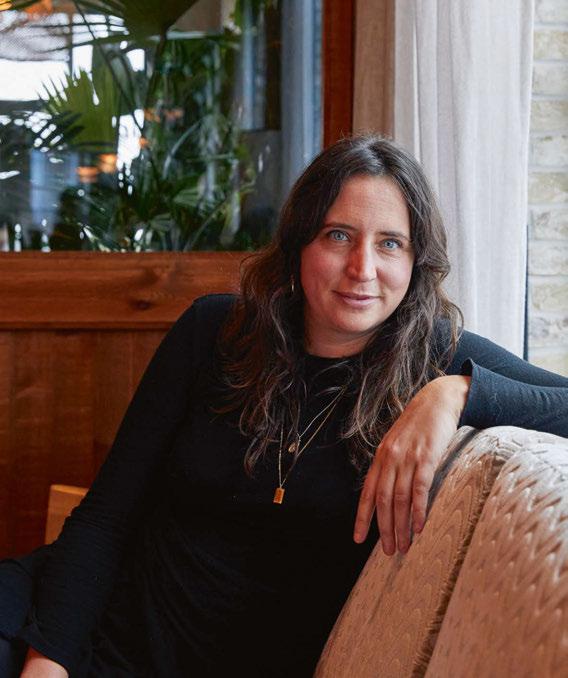
“Working with partners to create new concepts and help grow their brands and businesses is one of the things that we’re really keen to double down on.”
JULES PEARSON
ways to make as many revenue-generating spaces as possible, transforming untapped square footage or back-of-house areas into creative F&B pockets.

Cookie-cutter formulas have no place in the Carte Blanched playbook, and the team’s insistence on developing venues that make sense within the context of their communities extends to the process of launching new outlets from existing brands. “Even with the brands that we roll out in multiple different locations, every single one of them is tailored to the locality,” explains Ghalleb. “Although the brand might be the same, the colours will change, the graphics will change in some way, the menu direction will change to suit the local culture; so we’re almost reinventing the concept every single time, it’s never a cut-copy-paste effect – which would be 10 times easier!” Brown adds: “It’s about really incorporating a local touch as much as we can and putting the right people into those places.” The beauty of working as part of a fully dedicated studio is that the team
is able to draw on its in-house graphic and interior design teams in such circumstances.
What’s next on the cards for the Carte Blanched team? With multiple openings and brand launches in the pipeline, the studio is spinning plates on various fronts. “The offerings are vast,” says Ghalleb. “It’s not just restaurants and bars anymore; it’s restaurantbars, café-bars, nightclubs, beach bars, food halls, bodega-delis… the opportunities are endless. It’s a dream role for us; we get to create boundary-pushing concepts that better the experience for all guests inside and outside the hotel.”
Recent examples of this diversification include The Flower Shop, a space within the new Mondrian Mexico City Condesa that fuses F&B with a retail element for a flexible approach to revenue generation. The all-day café and concept store serves up coffee and pastries, while also acting as a florist, wine bar and newsagent-style spot that sells highend artisanal products, including local mezcals
and tequilas. A similar space opened up at The Hoxton Poblenou in Barcelona last year, putting a modern spin on the traditional Spanish bodega offering a curated selection of grab-and-go snacks, beers and low-intervention wines.
Though dealing with such a wide variety of people and working systems isn’t without its challenges, Carte Blanched’s in-house setup gives the studio increased control when it comes to brand protection. Furthermore, its position within Ennismore and working understanding of the hotel industry means it is uniquely set up to collaborate efficiently with hotel operations teams and cut through corporate red tape. “We can move faster being in-house,” says Pearson. For Brown, the ability to work as a single team and deliver a project in its entirety elevates the studio’s offer as well as that of the hotel. “Guests want a holistic experience,” he concludes. “Good food and drink is the benchmark of any restaurant, so being able to add to this across culinary, creative and operations is what really sets Carte Blanched apart.”

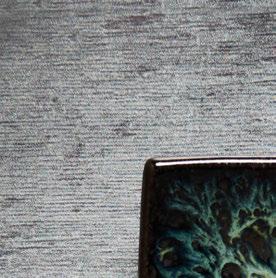















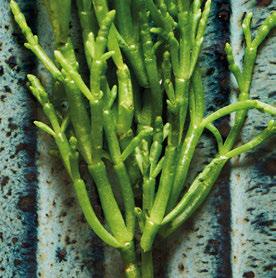











Rogelio Garcia knows a thing or two about Mexican cuisine. Born in Mexico City, the chef has cooked his way north through California –where cuisine is heavily influenced by Mexican fare – and has even penned a cookbook detailing his passion for the region’s best-loved dishes. Most recently, Garcia has been appointed to head-up Auro, a fine-dining restaurant at Four Seasons Resort Napa Valley, serving a fivecourse tasting menu that changes weekly.
One of his signatures is the Dry-Aged Shima Aji, a striped jack fish dish that evolves with the seasons – a spring version could incorporate heirloom tomatoes for example, while stone fruits come into play in summer. “This is my take on a classic aguachile, which translates to ‘spicy water’ in Spanish,” explains Garcia. “It
is an entirely a unique creation inspired by the flavours of my childhood spent in Mexico City.”
To make the dish, the Shima Aji is sliced thinly, then rolled together with avocado to form a delicate flower. It is then dressed with a spicy yuzu vinaigrette of wild Napa Valley kiwi, Oro Blanco grapefruit, ice lettuce and cucumber – poured tableside – and garnished with violas. While the fish is sourced from Japan, all other ingredients are procured from the hotel’s garden and local purveyors in Napa Valley. “This dish brings forth my Mexican heritage as well as a passion for Northern California produce,” Garcia concludes. “I feel inspired working in wine country and am excited to tell the stories of local farmers and their ingredients through my cuisine.”


ASTURIAS
The Spanish equivalent of French Toast or the classic British bread-and-butter pudding, Torrijas is a traditional dessert comprising slices of bread soaked in a mixture of milk, egg, sugar and in some cases, wine or honey. Dating back to the 16th century, the dish was once favoured by Catholics as a source of nourishment during Lent, but has since been reinvented many times over. Now, Tella – the signature restaurant at CoolRooms Palacio de Luces – is putting its own spin on the classic for the next generation of diners looking to experience a taste of Asturias.
Chef José Francisco Ruiz’s reimagining of the Easter dessert retains the fundamental flavours of the original, yet is served in a new way. “The Torrija Tella is an evolution of the

traditional Asturian torrija, made with slices of stale bread, usually a couple of days old,” he explains. “We transform it, we dry it and make our own brioche bread.”
Asturian milk is infused with cinnamon, lemon and vanilla before eggs are added to make a light pastry cream. The torrijas are soaked for 24 hours, then fried in butter and topped with a citric crumble. Adding his own special touch, Ruiz serves the dish with cream of rice pudding, bringing together the region’s two best-loved desserts. For locals, it evokes memories of times gone-by, while for Ruiz, there’s a greater objective. “It’s a dish made with only a few resources,” he concludes. “Nothing is wasted, which is what I like most.”





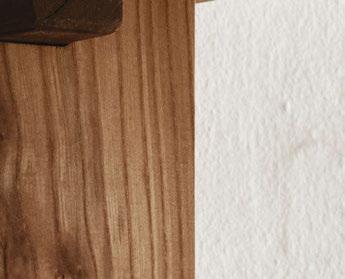







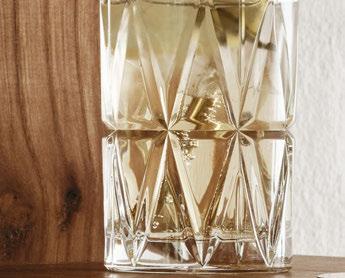



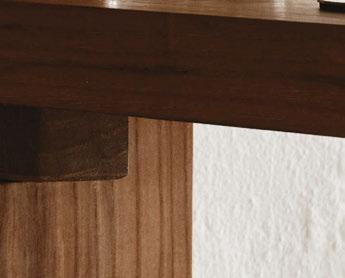






The Martini is enjoying a well-deserved moment in the spotlight, so how are hotel bars putting their own spin on one of the world’s most iconic cocktails?
Words: Millie MillikenThere’s something magical about a Martini,” believes bar founder and mixologist Ryan Chetiyawardana. And judging by the vast array of iterations served at his venues around the world, the man behind the internationally renowned Mr Lyan is well and truly under their spell.
And he’s not the only one. Martinis, predominantly of the dry variety, are enjoying a rise in popularity of late with bars embracing all kinds of variations on the classic serve. From its best-known contemporary guise – gin and dry vermouth with an olive or a twist – to the divisive Dirty Martini. Even the once-maligned Vodka Martini is making a comeback, perhaps in part due to the growing interest in characterful, non-flavoured vodkas emerging onto the market and throwing the gin movement into a bit of a spin. Indeed, this simple yet iconic serve is a mighty weapon in the bartender’s belt.
A quick call out on social media for the best hotel bar Martinis sparked a flurry of responses from both drinks industry professionals and avid fans. There were signature twists, such as the Walter Gibson (gin, vodka, Viognier, pear eau de vie, beeswax and pickled vegetables) at Nomad London’s Side Hustle; the Oyster Shell Martini (Isle of Blue oyster gin, Martini Bianco vermouth and Mara seaweed oil) at Glasgow’s Kimpton Blythswood Square; and the Gibson (vodka or gin, Riesling, mancino vermouth secco , mancino vermouth bianco, Tio Pepe and onion essence) at Darkside in Hong Kong’s Rosewood; as well as standout classics from the likes of The Whitby in New York and Le Magritte at London’s The Beaumont.

A recent trip to the brand-new Vesper bar at The Dorchester resulted in sampling the Vesper Martini, a heady mix of vodka, Old Tom gin, Amontillado sherry, and Forbidden Fruit liqueur. Served barside against the backdrop of Martin Brudnizki’s rich décor, this Martini moment encapsulated the magic that Chetiyawardana was talking about.
So how are bartenders capturing the zeitgeist when it comes to such a well-loved, and often purist serve? And how can hotels put their own spin on perhaps the most personalised cocktail on the menu?
The best place to start is with one of the most iconic Martini offerings in the world: that of The Connaught Bar in London. Served from its Martini trolley with the now-famous high pour and a selection of bitters for guests to choose from – the bitters being a clever nod to historic Martini recipes – it combines familiarity with a sense of theatre as well as the option for guests to personalise their serve.
Bar manager Maura Milia credits the continued popularity of the bar’s signature to its delivery. “Service is all about the individual, and while all our team members implement a specific vision and approach that is characteristic to The Connaught Bar, they also add their own individual touch,” she explains. “This means that there’s interaction with the guest that is tailored to the occasion, profile and mood of the person they’re serving; we make guests feel part of the cocktail-making experience.”
The bar menu also lists a Vintage Martini using both 1970s Gordon’s Dry Gin and Martini Extra Dry vermouth which, at £140 per serve, gives Martini lovers something extra-special to celebrate with.
Back over at Mr Lyan, Chetiyawardana sees the uplift in Martini’s popularity a result of consumers’ growing love for cocktails: “People are enjoying cocktails so much more as part of their imbibing experience and nothing quite sets that up like a Martini.” He also notes a growing interest in spirits themselves and a
change, perhaps, in palates. “I think people are looking for drier serves and want to be able to taste and understand the base spirit, in much the same way Old Fashioneds have helped people understand whisky.”
He remembers a time when Martinis were seen as a faux pas, particularly those that strayed from the classic, but times change, and Mr Lyan’s serves now adapt to the character of the venue. Lyaness in London’s Sea Containers for example, showcases the sweet and textured Cereal Martini, as well as the off-dry Imperfect Martini and the Elephant Martini, which leans into the current tendency towards more savoury serves. His other London outpost, Seed Library at One Hundred Shoreditch, offers a Sancho Leaf Martini that plays with texture and temperature as well as the notes of the Japanese plant.
In Amsterdam, Super Lyan at Kimpton de Witt lists the Libecans Martini, which has “extra everything” and goes big on vermouth and bitters. And further afield at Silver Lyan in Washington DC’s Riggs hotel, Chetiyawadana and team approach the Martini with a US audience in mind. “When I first visited the city, I would see people ordering Martinis in the classical American style – either dry or dirty,” he explains. “We wanted to create a version that appeals to guests yet is bespoke to us, playing to the details we love about the drink.”
Chetiyawadana also prioritised service, opting for beautiful glassware and a silver tray of garnishes, aptly naming the concept as Silver Service Martinis; unsurprisingly, it’s one of the bar’s biggest sellers.
While dirty and theatrical serves abound elsewhere, over at Gleneagles in Scotland, The American Bar is focusing on gin. “In my opinion, the Martini remains the purest iteration of a gin drink, enabling guests to experience the spirit to its fullest,” explains Michele Mariotti, the hotel’s Head of Bars. An ode to juniper, the Juniper Martini is a collaboration with South Loch Distillery as part of the venue’s The Book of Berries menu. It’s a stripped-back version of a classic using sherry in place of vermouth and, crucially, eschewing the multi-botanical approach of gin. “With the gin boom, we noticed an increase in brands creating flavoured gins, which I feel overshadows the incredible flavour that the juniper berry creates,” he explains. “Considering the diversity that one can achieve through a single ingredient when producing spirits like whisky, vodka or brandy, we questioned whether we really needed all those botanicals to achieve diversity.”
The answer was a resounding no, and as such, the bartender has created three mono-botanical gins that are presented as a taster from which the guest selects their favourite. This is then used to make a 5:1 Martini, with the sherry replacement also reducing the number of botanicals in the final serve. Much like Chetiyawardana, Mariotti
“People are looking for drier serves and want to be able to taste and understand the base spirit, in much the same way Old Fashioneds have helped people understand whisky.”
RYAN CHETIYAWARDANA
sees the serve as a perfect opportunity for guests to truly understand the core ingredient of the cocktail. “We really believe that using a Martini as the vessel for this is the most perfect way to shine a light on the spirit and the botanical without compromising on its flavour.”

So what of the purists? Are guests happy to be led by hotel bartenders or do personal preferences reign supreme? “Our guests trust us on our picks, and the Silver Service option is no different,” explains Chetiyawardana of the reputation built by the team around their Martini offerings. “We were once told that 50:50s and wet Martinis were not part of the national palate in the UK, but they’ve been similarly popular; it’s great to see them become repeat serves and new favourites.”
Over at The Connaught Bar, Milia sees personalisation prevail, not only with the choice
of bitters but also with the base spirit. “While everyone has their own preferred version, our guests rely on us and our Connaught Martini specs of 75ml base spirit, 15ml Connaught vermouth mix and personal choice of aromatic bitter. Plus they enjoy the bespoke elements we offer on our Martini trolley.” Of course, the knowledgeable team can also offer recommendations to guests in need of guidance. For Marrioti, honouring the core of a Martini means playing with new flavours or techniques that are more easily accepted in lieu of personal preferences. In fact, he sees the freedom of working in a hotel bar as a way of being able to give guests more choice. “There are occasions where, as a hotel bar, we benefit from certain liberties simply due to the wider ecosystem around us. Be that customisation of products or ad-hoc food pairings – all of this helps with meeting the personal preferences of such a classic drink.”
“The Martini remains the purest iteration of a gin drink, enabling guests to experience the spirit to its fullest.”
MICHELE MARIOTTIA collaboration with South Loch Distillery, the Juniper Martini at Gleneagles uses sherry in place of vermouth and eschews the multi-botanical approach of gin



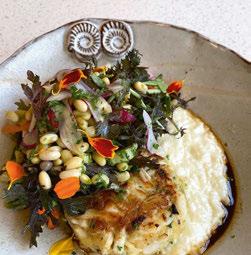



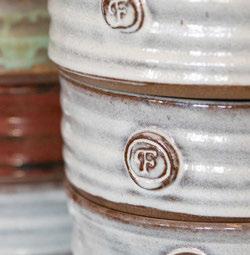
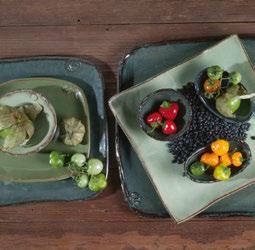








“Pour yourself a drink, put on some lipstick, and pull yourself together,” are the words of iconic Hollywood actress and former Beaverbrook Estate guest Elizabeth Taylor. The well-known edict also serves as inspiration for a special cocktail at the hotel’s signature bar. Designed to be enjoyed in the presence of loved ones in the surrounds of Sir Frank’s Bar, Kiss! combines Havana Club rum with pomegranate purée, freshly squeezed lime juice, egg white and rose cordial. To create the romantic concoction, the ingredients are combined and shaken over ice before being double strained, poured into an elegant coupe glass and garnished with a spritz of rose essence. The real magic happens at serving, when crushed dried raspberries are dusted over a lip-shaped stencil. “It’s fun and whimsical yet still luxury, which is what we strive to offer here at Beaverbrook,” explains Bar Manager Alan Cook. “It’s an interactive experience too, with the drink served on a vintage glass tray that hangs around the bartender’s neck.”
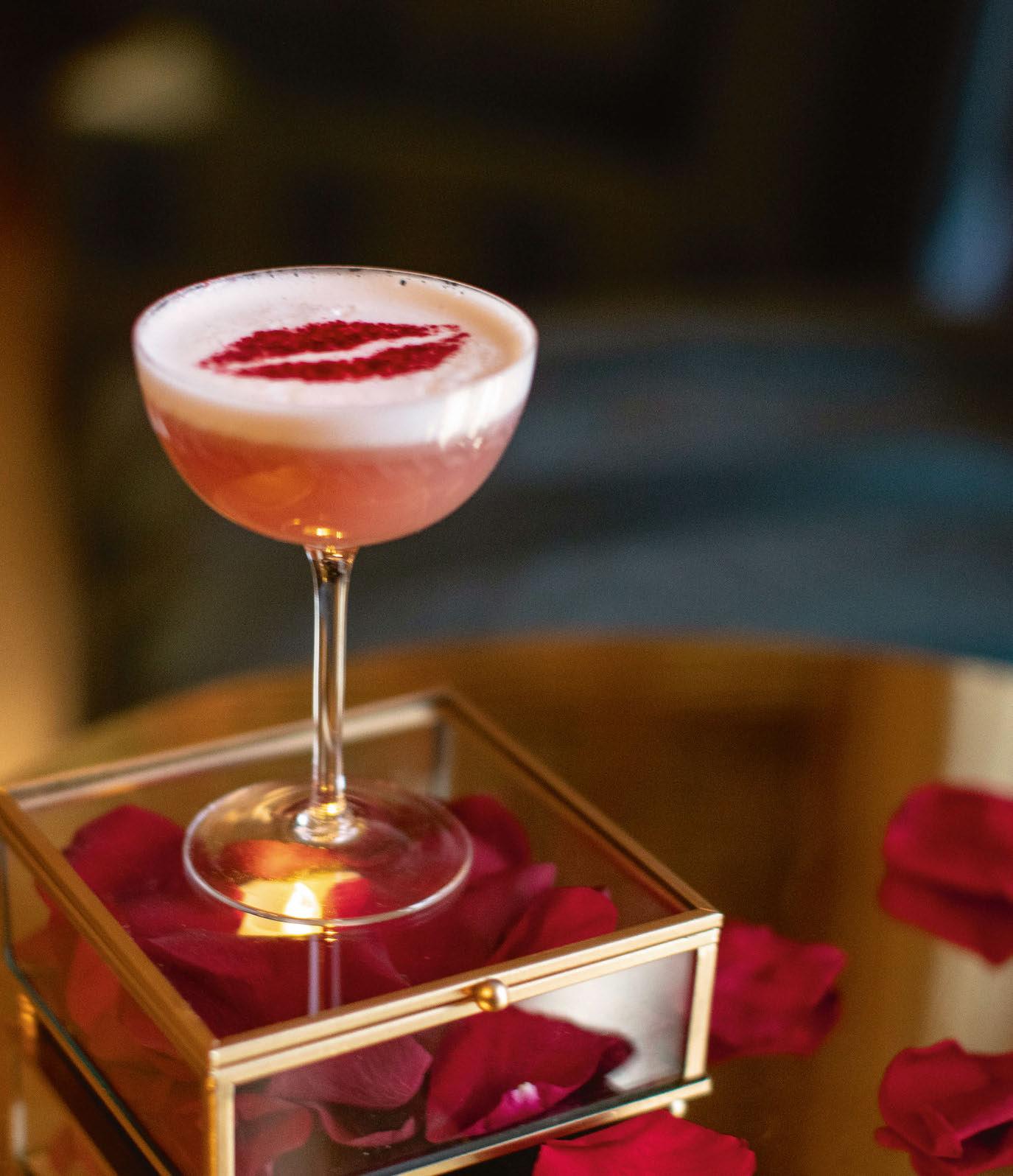

















































































































DISCOVER SEAGULL FRONT BAR
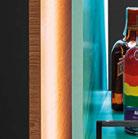
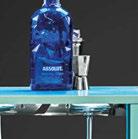
Bartender Emanuele Balestra has long been infatuated with scent – so much so that he moved to Cannes on a mission to create a perfume that smells good enough to drink. As Manager of Fouquet’s Bar at Le Majestic Hotel, he now operates an on-site laboratory that transforms fragrant botanicals grown in the hotel gardens into complex tinctures that enhance his cocktail creations. A highlight of his Edible Perfumes menu is the Bloody Majestic, a reimagining of
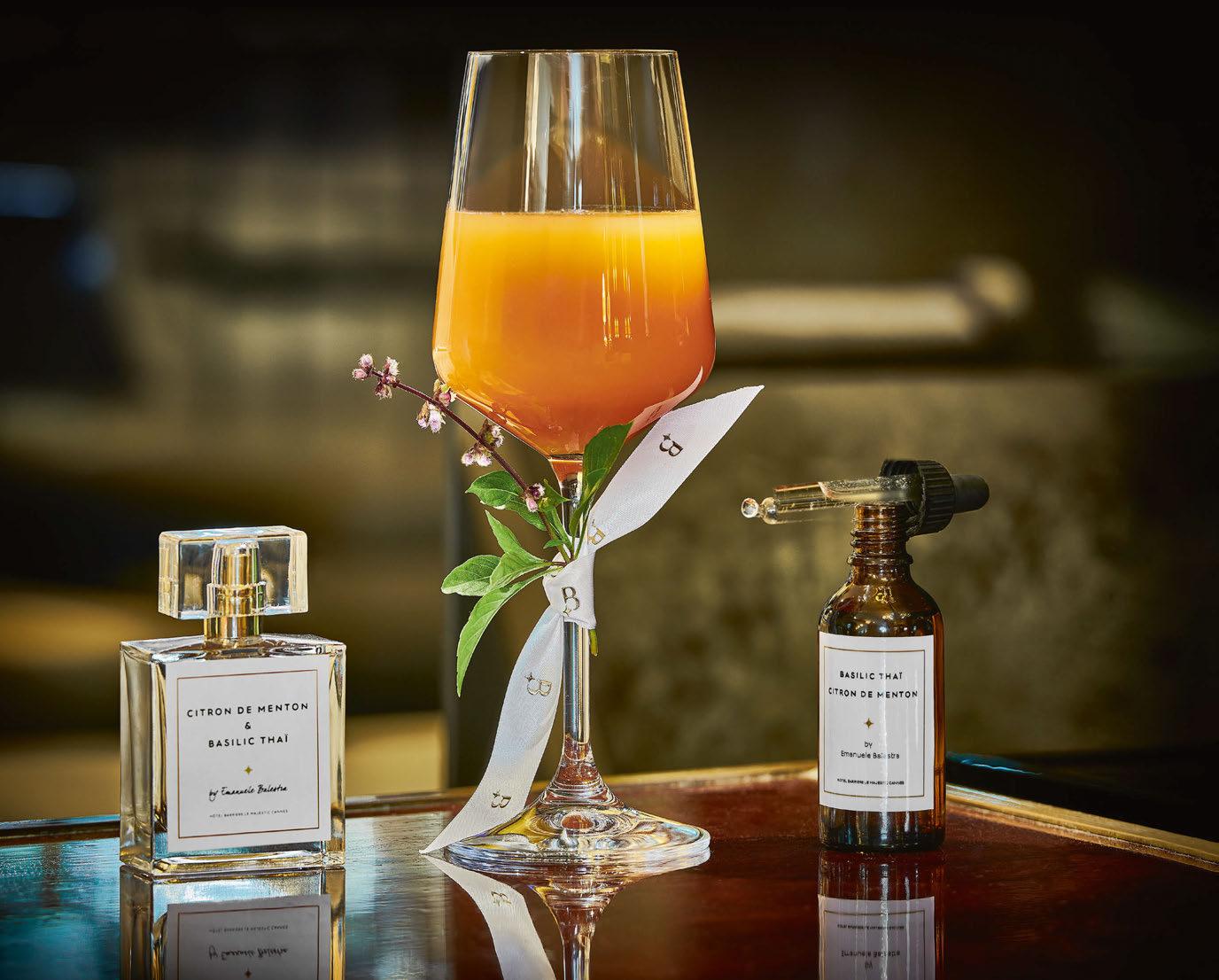
the classic Bloody Mary, made with Kokuryu Ryu Daiginjo Gold Dragon sake, Polish Polugar Rye Vodka, yellow tomato juice, celery salt, Worcestershire sauce, bitter lemon and Thai basil. “The initial idea was to capture the same savoury and culinary elements of the classic Bloody Mary, but with a more delicate approach, to distil down its essence and to create something unconventional, allowing the ingredients we grow in Cannes’ unique climate to shine,” explains Balestra. The imbibing experience is completed by a bespoke edible perfume prepared to enhance the flavours within the drink, taking on the role of a garnish. Carrying notes of the Thai basil and Menton lemon used in the bitters, the perfume is sprayed inside the glass up to the ribbon, allowing the scent to interact with the cocktail and magnify the taste. Balestra adds:
“Working with so many different herbs and plants, it was a joy to craft the same savoury notes with our finest ingredients, and amplify them further through the edible perfumes.”
An elegant, technical and versatile crystal glass stemglass
A chimney in the upper part of the bowl for a unique design, a high level of comfort in tasting, but also to attenuate the perception of alcohol in young wines

First created in 2017, the Fantastique Rosé cuvée – Cru Classé des Côtes-de-Provence – is a balanced, structured and precise rosé wine. It features a blend of Grenache, Cinsault and Vermentino grapes grown in siliceous clay with fragments of quartz and pebbles on the well-exposed slopes of the Château Sainte Marguerite vineyard. For the 2022 edition, the year presented challenging weather conditions; both spring and summer were marked by drought, with very high temperatures recorded in July and August. Yet, at harvest there was a good balance of sugar and acidity thanks to continued ripeness. To produce the certified organic and vegan rosé, the grapes underwent cold skin maceration before pressing, followed by thermo-regulated fermentation, maturation in tanks on the lees before fining and filtering took place prior to bottling. On the nose, the shimmering pink cuvée offers a blend of pear and vine peach aromas, alongside notes of exotic fruit, notably guava and grapefruit zest. The palate is characterised by intensely fresh aromas with floral accents of rose and a hint of jasmine before it reaches a rich, generous finish, which prolongs the taste experience.
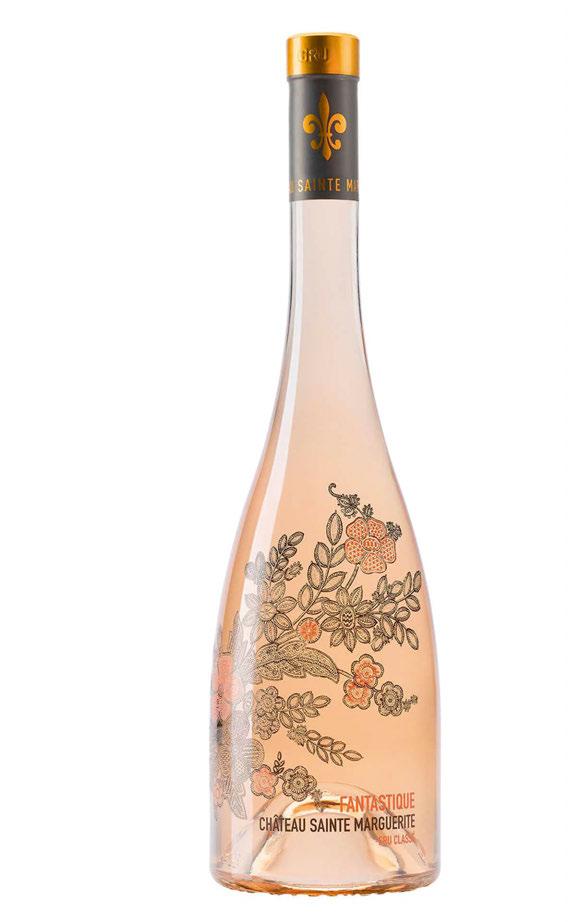
Fantastique Rosé 2022 complements seafood, particularly crab or shellfish. The wine also reveals its personality with the sweet, fragrant spices of Mediterranean cuisine, as well as with ginger, citrus and exotic fruits.
www.chateausaintemarguerite.com
TO THE TABLE ASIA is the most productive and valuable event for leading restaurant and bar suppliers seeking to do business with Asia's most prestigioushotelandrestaurant groups.The eventinvitesexclusivelythesenior group-level decision makers from hotel operators, restaurant groups and procurement companies, so that attendees can connect at the highest level.




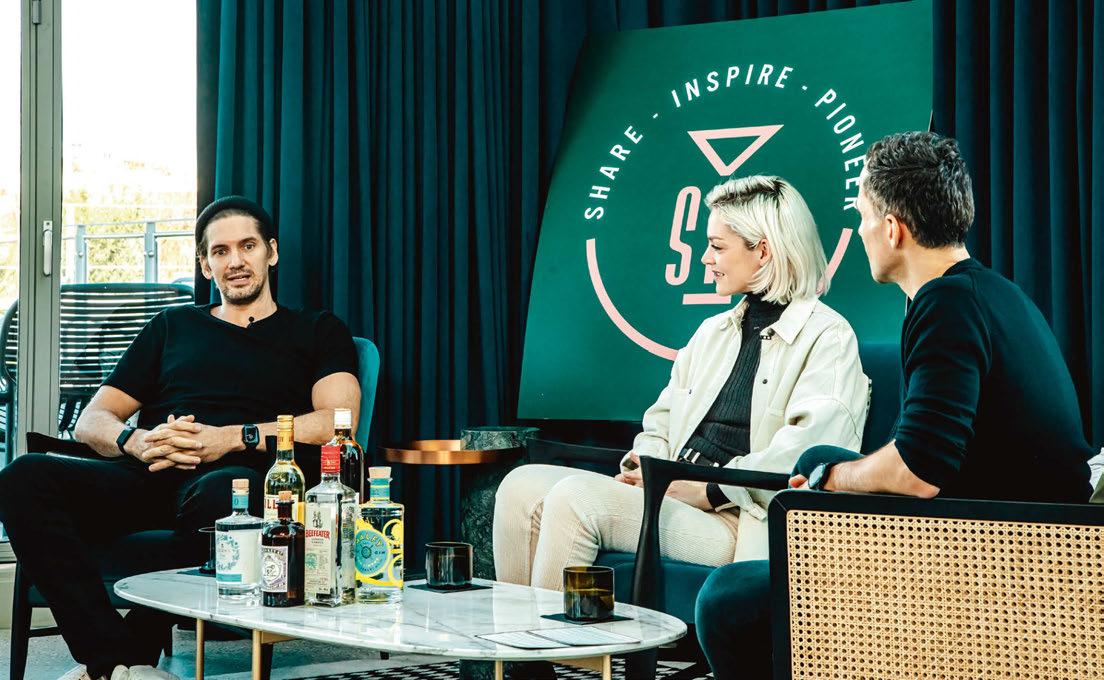
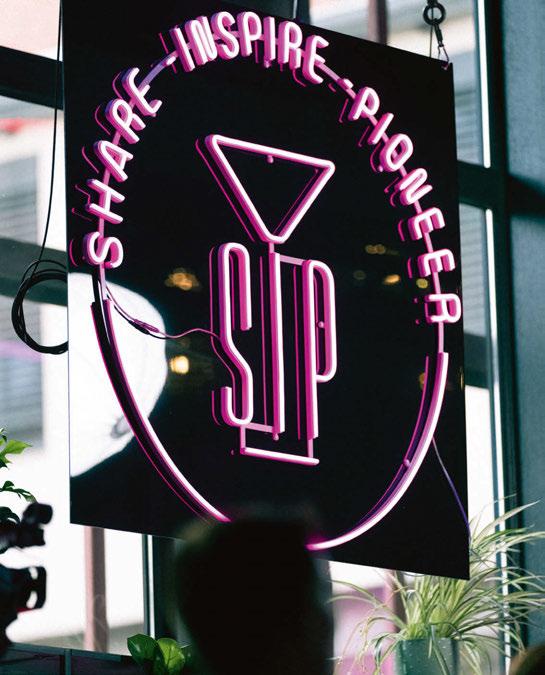

Pernod Ricard has hospitality running through its veins. More than a supplier, the self-proclaimed créateurs de convivialité has been supporting industry professionals since its inception. So when the conglomerate decided to launch an interactive community platform for the industry’s movers and shakers, it kickstarted a global movement.
SIP – an acronym for ‘Share, Inspire, Pioneer’ – was initially born out of a desire to consolidate the company’s many different brand-led trade advocacy programmes, whilst also wanting to offer an alternative to the wealth of bartender competitions that often attract the same crowd. But, like with many creative processes, the team soon realised that the programme could serve a greater cause. “What started off as a way for Pernod Ricard to promote itself and its brands, ended up being about the hospitality industry as a whole – not just bartenders, but the owners, F&B managers, festival organisers and nightlife advocates,” explains Niall Gately, Global OnTrade Director at Pernod Ricard. “Our brands can still play a role, but fundamentally we realised that we wanted to do something for the trade. So we asked ourselves, how can we work collectively to lift the industry?”
The result is an interactive community platform designed to bring hospitality professionals together – both online and inperson – to inspire one another through the sharing of ideas, knowledge and passion that will ultimately shape the future of the sector.
Part of the offer is a dedicated website featuring compelling original content, events and training that runs the gamut from industry-focused news and analysis to podcasts, videos and expert talks. To curate this content, Pernod Ricard enlisted the expertise of three industry figures: Sandrae Lawrence, co-founder of The Cocktail Lovers magazine, and Mirik Milan and Lutz Leichsenring, co-founders of night-time culture and advocacy movement VibeLab.
“We don’t want to have the usual top-down approach, with the brand imposing their views or giving strict guidelines on how to consume or serve the product,” states Cyrielle Lentz, Head of Cultural Partnerships & Trade Advocacy at Pernod Ricard. “This is a platform that has been designed by the hospitality community, for the hospitality community. With SIP, we really want to give members of the industry a platform to tell their stories and share their ideas and vision for the industry. We’re not only showcasing the world-class talent, but also shining a light on the unsung heroes of hospitality.”
Additionally, the collective offers practical advice from pioneers across the global drinks community, touching on topics such as menu curation, preventing burnout, creating safer bar spaces for women and normalising failure. And SIP is currently developing an ESG selfassessment tool with tangible metrics to determine how sustainable their business practices are, and practical advice for a more environmentally friendly approach.
Integrated into the platform is PBT, Pernod Ricard’s Professional Bar Training e-learning programme, which is the first fully accredited online education programme created specifically for bar professionals to progress their careers. Developed in partnership with London-based drinks agency Strange Hill, the in-depth vocational course is broken down into modules that can be undertaken remotely and at any time, allowing bar professionals to easily fit study around the long hours of the industry, while advancing their education and careers. In addition to teaching core skills such as beverage knowledge and drinks-making techniques, the programme covers pragmatic issues integral to success, such as licensing laws, sustainable bartending, responsible service, sales and marketing and financial business management.
Two years in-the-making, SIP is already building quite a following, both online and inperson. As Pernod Ricard continues to roll-out more and more virtual and physical gatherings that best support their members, the ultimate goal is to be the industry’s best ally. There’s even talk of an annual global event that brings the entire community together.
“We share the same passion as the trade, so with SIP we’re trying to show that we’re partners,” concludes Gately. “They provide the venue and we provide the product. Together we have a shared mission to provide consumers with fabulous experiences and lasting memories.”
www.join-sip.com
6-9
It was with enthusiastic anticipation that senior corporate decision-makers and suppliers from the Middle East and Africa’s hospitality sector gathered this March, eager to explore the wealth of opportunities on offer for the region’s F&B.
More than 130 delegates gathered at Conrad Abu Dhabi Etihad Towers for To The Table’s three-day programme of meetings, thoughtprovoking seminars and networking dinners. Returning companies among the 39 buyers in attendance included hotel groups Hilton Worldwide, Marriott International and Jumeirah Group, all of whom were represented by new delegates. On the supplier side, Craster, Pernod Ricard, Steelite and Revol were among familiar returnees, while Nespresso, Bugatti and Rona made their debut.
After the initial buzz of the welcome dinner at the hotel’s Nahaam Terrace, To The Table MEA 2023 kicked off with the first of four seminars tackling topical issues facing the region’s hospitality sector. Chaired by writer, editor and media consultant Devina Divecha, each panel

showcased a range of expert viewpoints and invited audience participation for an engaging discussion of the topic at hand.
Entitled Designing for the Future, Where Luxury & Sustainability Co-Exist, the opening seminar explored the burgeoning relationship between sustainability and design. On stage were Robert Juntke, Vice President of F&B EMEA at Marriott International; Marcos Cain, Principal and founder of Stickman Tribe; and Pinar Calimano, Director of Design and Innovation EMEA at Four Seasons Hotels & Resorts. The subject of restaurant design for the years to come sparked a lively debate about the role of designers in creating sustainable concepts, with Calimano stating: “As designers, we have a responsibility to create experiences that are kind to both the planet and people. We can design to increase efficiencies and minimise impact. We can design to use sustainable products, source local materials and we can create concepts that support local communities.”
Hotel development in Saudi Arabia was the
topic on everyone’s lips during the conference, particularly during the engaging second talk, Ambitious Saudi Arabia – From Futuristic Cities to World-Class Tourism. Three figures with the inside scoop – Oliver Harnisch, Senior Strategy Advisor for Saudi Arabia’s Ministry of Tourism and founder of Lunasole Hospitality; Stefan Breg, Managing Director for KEANE; and Abdullah Al Muslemani, CEO of Crown and Company and Sora Saud Trading Company –discussed the growth of hospitality in the region and how the acceleration of cultural and social changes are creating more opportunities for the F&B industry. After a full day of business, delegates were transported to nearby The Abu Dhabi Edition, where they enjoyed a cocktail party and dinner at Alba Terrace.
Independent restaurants and bars were the topic of conversation at the third seminar, in which Michael Marlay, Chief Operating Officer at Tashas Group; Naim Maadad, Chief Executive and founder of Gates Hospitality; and Yannis Stanisiere, Chief Operating Officer for Coya,
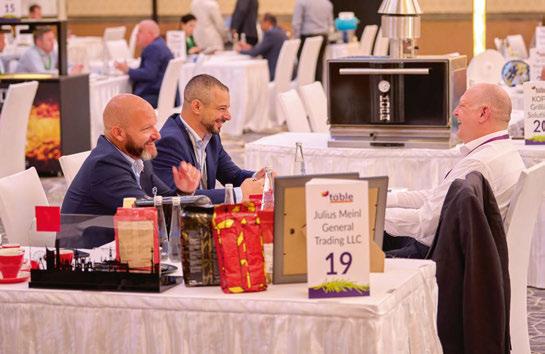


offered their thoughts on the rise and success of independent groups in the MEA, highlighting the innovation, creativity, flexibility and risktaking demonstrated by the sector. The trio also explored the potential for new business opportunities if hotels teamed up with independent F&B groups. “We’re already seeing that the relationship between independents and hotels is becoming stronger as we gain a wider understanding of both parties,” commented Maadad. “I think the main positive impact of this, is that hotel owners are now realising that value that could be added by an independent spa or restaurant. If you combine two powerful businesses that excel at what they do, the future will be bright.”
The fourth and final seminar saw leading F&B experts Sebastian Nohse, Senior Director of Culinary EMEA at Hilton Worldwide and Joseph Chalfoun, Area Restaurants & Bars Director MEA at Radisson Hotels Group, discuss the importance of in-house restaurant concepts that engage with both hotel guests and the local
community. The duo also highlighted the impact of the recent introduction of international F&B awards to the region, such as the Michelin Guide and 50 Best. “There are approximately 13,000 restaurants in Dubai – one of the highest per capita restaurant concentrations in the world –but not all of them are quality,” noted Chalfoun. “With the entrance of these schemes into the market, it is going to put the onus back on operators to make sure that they are looking at the standards of the food they’re serving and the concept.”
With the first To The Table event of the year a triumphant success, the itinerary was rounded out with a farewell gathering at Conrad Etihad Tower’s Michelin-starred restaurant Vakava, where friends old and new reminisced about the highlights of their week over cocktails and Latin American fare.
The next To The Table will take place in Kuala Lumpur from 26-28 September 2023. www.tothetableasia.com

With the coffee machine market growing at a rapid rate, the latest launches offer the best of both design and innovation.
Drinking coffee has become an intrinsic part of a hotel guest’s daily routine; whether it’s savouring the finest beans with a croissant at breakfast, getting a caffeine boost during a conference break, relaxing in the bar with a post-dinner espresso or even a quick pick-me-up from the comfort of one’s own room. The rapidly growing popularity of non-alcoholic beverages amongst millennials, for which coffee is an obvious alternative, as well as seismic shifts in consumer tastes and growing demand for greater choice and quality, means coffee serves within hotels are facing a new wave of challenges that make existing equipment look increasingly like relics from a bygone era.
Tackling these obstacles head on, Franke Coffee Systems recently launched BeyondTraditional, a brand-new product category that connects existing concepts and technologies with emerging trends and customer demands to create solutions that go beyond industry standards. The first of these

solutions is Mytico, a pioneering line comprising various models equipped with innovative iQFlow technology that produces consistent, baristagrade coffee, whilst enhancing any location with its sleek Italian design. Ideal for hotel settings, the Mytico range can be fully integrated into Franke’s Digital Services, making it possible to monitor and manage either an individual machine or fleet remotely.
Time remains a highly sought-after commodity in the wake of the hospitality industry’s overwhelming staff shortages so a machine that is quick, efficient and easy to use is top billing for F&B directors when kitting out their venues. Nespresso’s Momento capsule machine range combines innovative design with cutting-edge technology to create a bespoke coffee experience with a well-planned and intuitive touchscreen interface that decreases training time. Skyrocketing energy bills pose another challenge for hospitality businesses, so any ways in which to reduce energy consumption are a bonus. In addition to next-
Quality and consistency are priorities for WMF (above left), while Modbar (above right) is breaking down barriers between baristas and customers with under-counter systems
generation connectivity features that deliver remote diagnostics, Momento is equipped with sleep and standby modes that switch off the main components of the machine when not needed, as well as a proximity sensor to ensure the machine only wakes up from standby when required. Envisioned by Dutch boutique agency GRO Design, Momento exudes a contemporary aesthetic and environmentally conscious design that enables it to be easily repaired, reused and recycled. A hotel’s wide range of guests, each with their own discerning palates, are sure to find a flavour profile to their liking amongst the 16 permanent Nespresso Professional fullyrecyclable aluminium capsules on offer, from long American brews to short shots of espresso.
Time-saving is a key consideration in WMF’s product development too. WMF’s Professional Coffee Machines have always guaranteed that time-consuming and error-prone tasks – such as grinding and tamping beans or frothing milk – are performed automatically. But the new WMF espresso NEXT semi-automatic


portafilter is taking the process to the next level. A Auto Milk Dispensing option enables the system to draw the exact quantity of milk and foam it to the desired consistency, freeing up service personnel to take care of other customer needs. What’s more, the new Auto Steam function allows simultaneous use of the two configurable steam lances; as a result, two pots with different milk types can be made at the same time, doubling machine output and preventing cross contamination.
Whilst self-service has become increasingly popular post-Covid, face-to-face interactions remain at the heart of the hospitality experience and oftentimes professional coffee machines can unfortunately act as a physical barrier between barista and consumer. US company Modbar is tackling the issue head-on with its modular under-counter professional espresso system that is designed to create an openbar concept where baristas can freely interact and engage with customers. While the inner workings and technical components are hidden
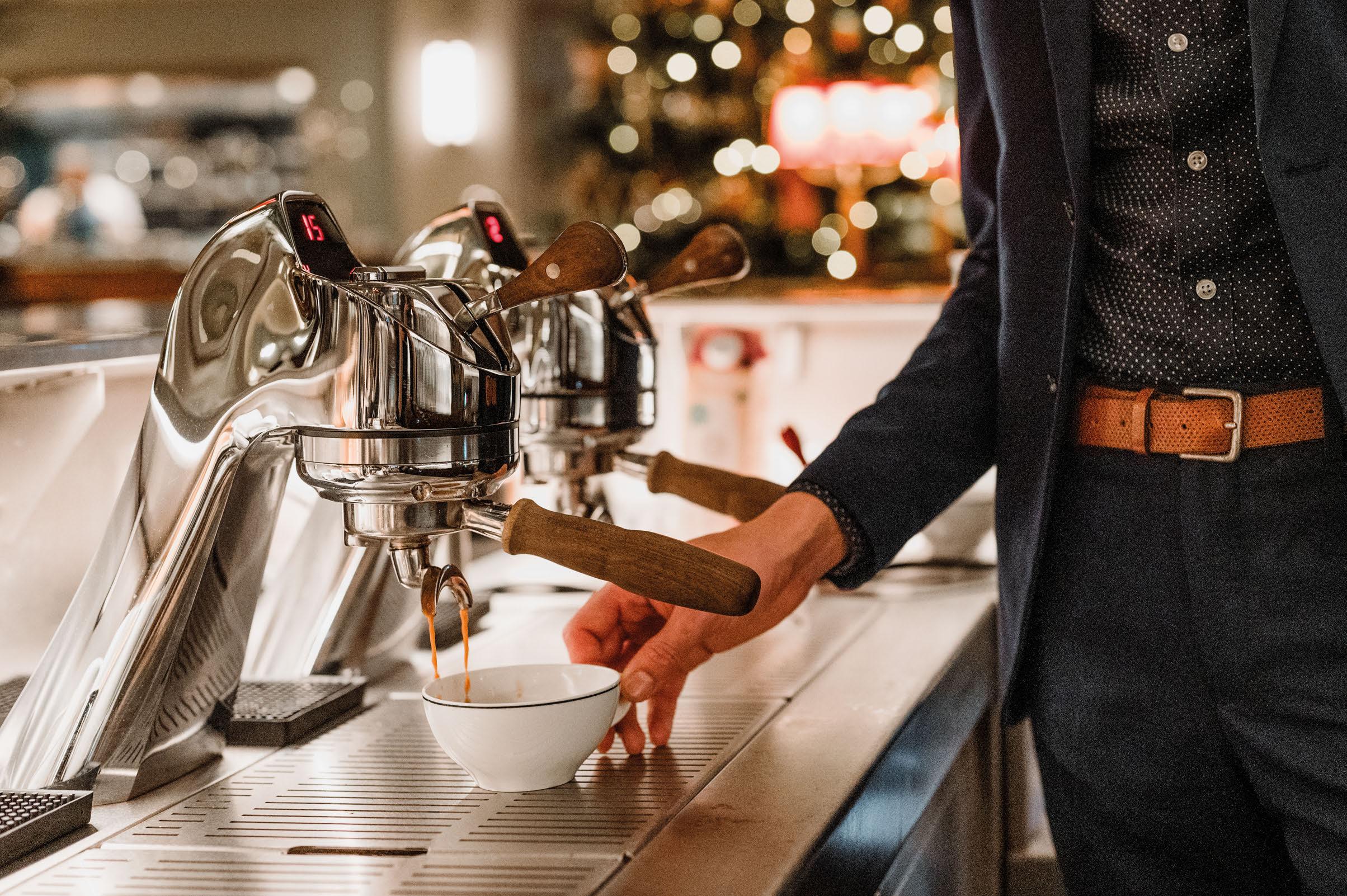
Fracino (top) and Franke Coffee Systems (above) are design-led, while Julius Meinl’s Iconic Hopper (above right) offers a nod to the past whilst embracing the future

below the counter, what remains on show is an elegant tap that can be fully customised with matte, chrome or metal finishes in any desired colour to complement surroundings. The tap’s minimalist presentation successfully conceals its technological features, such as optimal temperature stability, optional scaled and simple multi-position controls.
Stylish equipment continues to have an edge, and in design-forward F&B spaces, where spacesaving is not so much a concern, the espresso machine can be a focal point of the interiors. Whether the aesthetic takes the form of sleek and contemporary or vintage, the market has plenty to offer. British manufacturer Fracino understands the importance of attractive design yet also puts sustainability centre stage. Having long eschewed plastic trim or panel finishes for its machines, and implemented polished or coloured finish stainless steel as standard across its product line, the familyrun business continues to develop new models to fulfil the desires and expectations of today’s

creative barista. Today, Fracino’s portfolio is led by Romano. In addition to a full-length touchscreen panel for drink selection and the use of multi-level programme controls, the machine features a steam valve and filter holder handles crafted from real wood, lending it a sophisticated and slightly retro edge that is further enhanced by LED edge lighting along the side panels in cool white or blue.
Offering a nod to the past whilst embracing the future, the new Julius Meinl Iconic Hopper produces coffee as high-quality as its aesthetic, in line with the Austrian company’s family trademark that spans five generations. Its distinct design calls to mind the form of the brand’s signature fez motif, also featured on its own-brand cups, jugs and water glasses. Available in red or white, the statement machine features quality precision technology exclusively designed to ensure that the pressure of coffee beans entering the grinder is accurately controlled, delivering the perfect cup of coffee, every time.
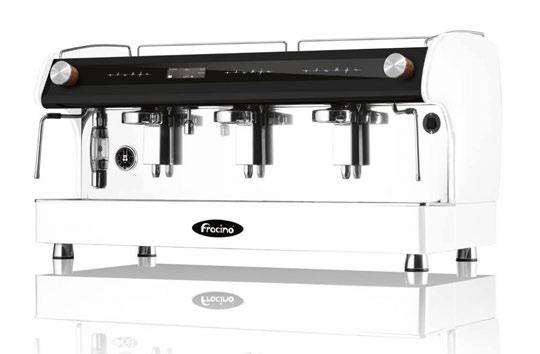












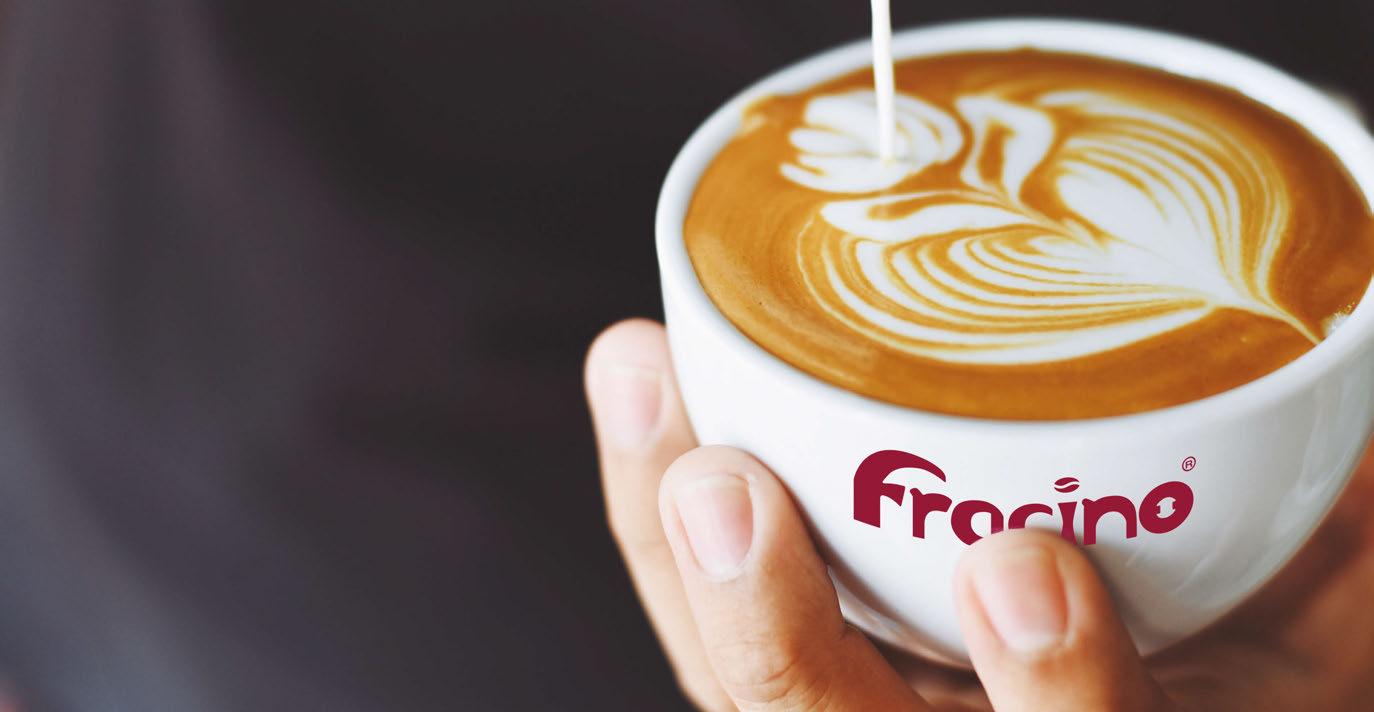


























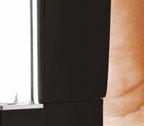




Our strikingly stylish Romano – the fusion of contemporary design and technology. Featuring a full length Touch Screen Selection Panel and LED Display, it’s stunning design is enhanced with Real Wood Handles, LED Edge Illumination and Barista Lighting in the coffee preparation zone.









Available in 2 or 3 group versions, the Romano boasts all the power, technical qualities and reliability synonymous with Fracino’s equipment range









Born from the desire to create a useful tool with a contemporary aesthetic, DryPod is a solid rack made from brushed stainless steel, PVD refined in either black or brass, with a removable translucent resin drip tray fitted inside. Primarily conceived as a drying rack for decanters, DryPod's geometry has been determined to ensure all Zieher decanters can be stored safely, from larger variations such as the Eddy, Star or Doppio, to smaller versions or even traditional decanters. As an etagere on the laid table or in a hotel guestroom, DryPod can be used in conjunction with other Zieher articles to present food and beverages in an impressive way. www.zieher.com

From Japan-based bone china manufacturer Narumi, Primadonna is a new dinnerware collection that is reminiscent of a diva’s dress. The graceful shape is inspired by chrysanthemums – a symbol of nobleness in Japanese culture – while the elegant pattern features shiny gold with lapis blue accents to enhance its luxurious feel. Made from bone china and manufactured in Narumi's mother plant located in Ise-Shima National Park, the collection exudes engaging glamour and elegance that would complement a sophisticated dining setting. Narumi’s eco-friendly manufacturing has allowed the factory to co-exist with nature for over 40 years.
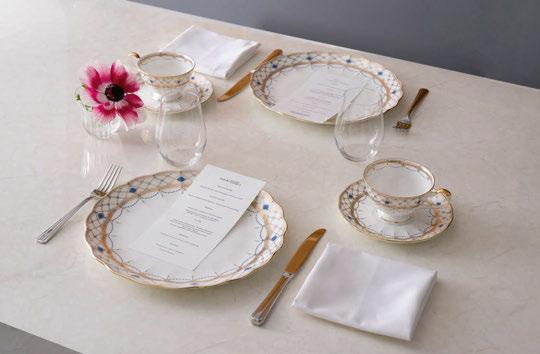
www.narumi.co.jp/en
Playground's first terracotta collection
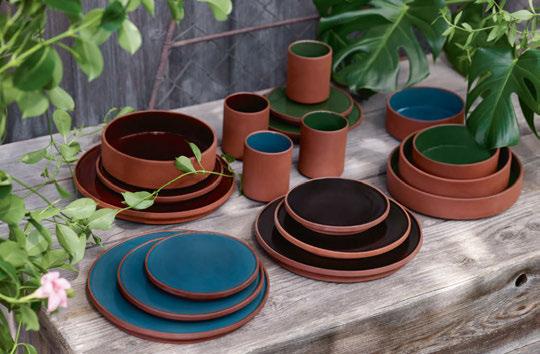
Jardim evokes the atmosphere of summer in Portugal. The reddish-brown body makes for a natural look, while the glazed tops and bottoms create an air of playfulness and variety. The collection is available in four different glazes: the lush green of vegetation, the cool blue of water, the warm black of shade and the rich red-brown of soil. The offset pedestal allows bowls to be covered with the correct sized plate. Playground is one of three timelessly functional and trend-conscious brands from BHS Tabletop, a manufacturer and supplier of professional, functional and inspiring tableware.
www.playground.de
John Jenkins is one of the UK’s leading designers and suppliers of crystal and glass for the high-end hospitality industry. Founded in 1901, the brand’s principal aim is to design and supply stylish glassware that remains practical in service and complements both wine and table.

The company keeps in stock a diverse and expansive range of both handmade and machine-made glassware that runs the gamut from wine and cocktail glasses to classic tumblers, all of which are available for immediate delivery. Collections range from Gala to its finest wine glass series Starr, a fully handmade glass intended for the serious wine enthusiast. John Jenkins' in-house design department also creates exclusive patterns of handmade glassware to suit the specific requirements of the global hospitality clients, including luxury hotels, fine-dining restaurants and world-class bars.
The brand also has showrooms in New York, with the US market served by its distribution centre in New Jersey. Each pattern within the glassware portfolio benefits from the latest advances in glass-making technology, which are implemented diligently to enhance the clarity, durability and scratch-resistance of the finished product.
www.johnjenkins.co.uk
MyGlassStudio’s Cube Cloche collection is ideal for room amenity presentations and pastry buffet displays. The modern, photogenic alternative to the ‘service under the bell’ experience comes in four sizes including a small, medium and large square cloche, as well as a rectangular shape. The range is dishwasher-safe, ultra-durable and food-safe, designed so that the colours don't peel off. The series can be delivered in opaque colours for unique uncovering and to act as a room decor item, as well as in transparent with 'macaroon' footed trays to protect the food whilst keeping the presentation visible. The cube cloche can also be customised for bespoke requirements. www.myglassstudio.com


Headquartered in Gembloux, Belgian cutlery brand Eternum will celebrate its centennial anniversary in 2024, marking 100 years as an influential brand in the design sector. Its core business has always been the creation and sales of cutlery and table accessories, focusing on the international hospitality industry in recent years. Eternum's steak knives have been specially designed to easily cut through meat. Orno for example, has a plain blade machined from professional 5Cr15Mov steel, to guarantee exceptional and long-lasting sharpness. The blade has a smooth cutting edge comparable to a professional knife, making it ideal for a clean cut.
www.eternum.com

Portugeuse heritage brand Vista Alegre operates in tableware, decorative porcelain pieces, hotelware and chinaware, among other areas. When designing new plates for fine dining, Vista Alegre appeals to those who best know the industry: the most celebrated chefs. This original relationship has resulted in unique and exquisite pieces that combine the primacy of the Vista Alegre design with the creativity and practicality demanded by excellent cuisine.
The Totem plate brings together Vista Alegre and Sergio and Javier Torres, two renowned Spanish chefs, whose career was defined by the remarkable role of their grandmother. The chefs' latest project is their two-Michelin-starred restaurant Cocina Hermanos Torres in Barcelona. Another of the Chef's Collection is Reef by Colombian chef and restaurateur Jorge Rausch, who is also a judge of MasterChef Colombia, Chile and Ecuador and his restaurant Criterión has been awarded in the Latin America’s 50 Best Restaurants list. Known for promoting ecological and social responsibility campaigns on the fishing and consumption of lionfish, Rausch used this inspiration for design of his plate.
www.hotelware.vistaalegre.com
It’s an exciting time for global award-winning foodservice and hospitality brand FOH. Based in Miami with worldwide shipping, the brand counts years of experience in research, design and development, as well as large amounts of technology investments, all of which have positioned the brand as an industry leader. Each piece is carefully thought out, from the materials to the processes and techniques used, allowing the brand to remain true to its dedication to aesthetics without sacrificing function.
Between recently integrating its two brands – room360o and Front of the House – and launching an array of new and innovative collections, the company is poised to make 2023 its best year yet. In keeping with this forward momentum, FOH is expanding its horizons in the European market by opening a new showroom in the Netherlands. Located in Haarlem just 30km from the brand's new distribution centre, the FOH European Studio is more than just a showroom; it is a space designed for creatives to experience the company’s extensive portfolio of both Front of the House and room360o collections in person.
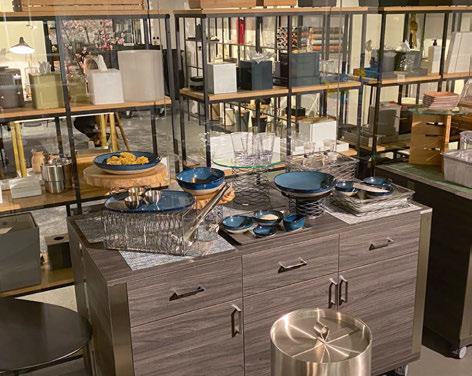

FOH manages its business like a family, and sees building lasting, service-driven customer relationships as the secret to its success. As such, the brand invites industry partners to schedule a guided tour of the new showroom with an FOH customer service expert so they can view and select pieces from tabletop solutions to bath essentials and other in-room accessory must-haves. The showroom will also host regular happy hours and events with swag-bags and merchandise give-aways www.fohworldwide.com
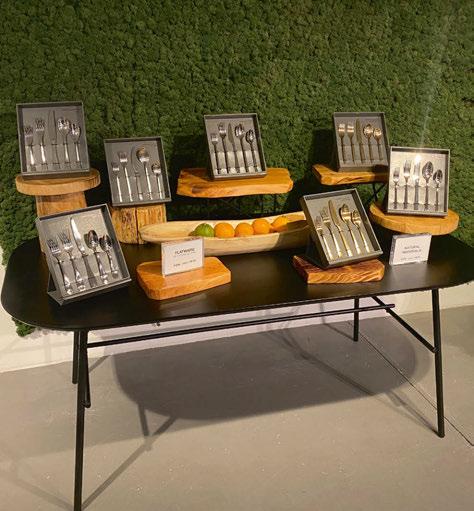
Porcel launched two new collections during Ambiente Frankfurt 2023. Empire Gold is a delicate collection with an intricate design shine and handpainted golden edge that gives it the signature luxurious finish of Porcel pieces. The charm of Empire Gold relies on its shape and unique texture, enabled by the tri-dimensional pattern and enhanced by the glazing of the porcelain, creating an impressive effect.
Empire silk is the result of Porcel's will to take the combination of tradition and innovation to the next level. It perfectly balances glazing and biscuit, on an all-white look that highlights the beauty, as well as quality, of Porcel's porcelain. The detailed pattern gives life and personality to the pieces of the set, seeking to change perceptions of white tableware. Designed by Studio Porcel, these collections can be mixed amongst themselves or paired with other Porcel collections.

Founded in 1987, Porcel is a prestigious Portugal-based brand and manufacturer of fine porcelain that combines handmade tradition and technological innovation to produce high quality, creative and elegant porcelain products.

www.porcel.com
Designed by Erika Lagerbielke in 1984, Intermezzo is a step away from the colourless aesthetic established at Orrefors in the 1950s, allowing the glass to be a visible and fun statement within a table setting. Yet instead of leaving Orrefors’ legacy of beauty and the tradition of craftsmanship completely behind, Lagerbielke took them both a step further. The Intermezzo collection, which is mouth-blown in Sweden, is more sensual than what past generations had been able, or dared, to make. Sealed into the glass, rising up from the surface of the table, is a teardrop-shaped enigma. The range comprises an Old Fashioned, DOF, Martini, Highball and Coupe glass. www.orrefors.us
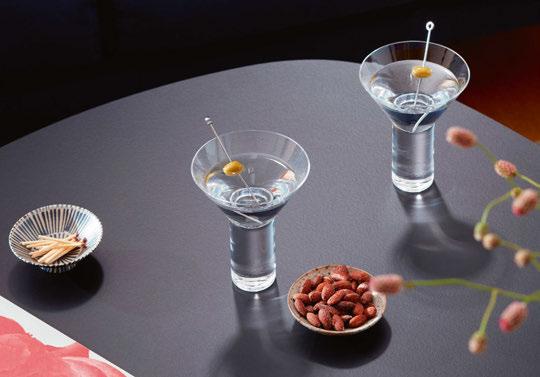
Founded in 1966, LSA international is a London-based design studio specialising in stylish and contemporary collections of glassware across the bar, table and decoration sectors. Inspired by the simple geometry of modern shapes and clean lines, a new set of mouth-blown pieces joins the Boris collection, making it a hallmark range of drinkware with an accompanying bowl for serving olives or nuts. The timeless profiles and classic forms create an aesthetic value that endures year upon year. Each piece is mouth-blown and hand-finished by master glassblowers, with the contemporary cylindrical forms anchored by Boris' signature thick, heavy bases. www.horeca.lsa-international.com
With the new Evidence collection of table glassware, Chef & Sommelier unveils a perfectly balanced design. With its short stem and angular bowl, enhanced by the brilliance and finesse of the crystal glass, its cold cut rim, the Evidence collection is the ideal mix of functionality and quality. The four capacities of the glasses of this collection allow industry professionals to ensure the effective and elegant service of wines, champagnes and prosecco or beers (in particular with the 45cl). All Evidence items are made with the brand's high-performance lead-free crystal glass material, Krysta, which is known for its lasting brilliance, shock-resistance and transparency.
www.chefsommelier.com

The Islands collection of whisky glasses are designed to liven up and upgrade any table arrangement. Crafted from lead-free crystal, the essential and functional design is noticeable for its simplicity in lines and the flared lip that directs the liquor to the tip of the tongue, emphasising its smooth, supple flavour. Meanwhile, the broad bowl of the glass, tapering toward the top, concentrates the liquid’s aroma and flavours, optimising the sensory experience. Launched in 2014, Nude is the first contemporary design brand from the Şişecam Group, a world leader in glass manufacturing and design with over 85 years of tradition, wisdom and expertise.

www.nudeglass.com
Founded in 2014 as the first HoReCa brand from the Turkish heritage company Kar Porselen, Bonna is dedicated to integrating new generation technological systems into its facilities and production processes. The Futura collection demonstrates the company's continued investment in this area by using AI technology that blends art, science and nature to design a collection of gourmet tableware comprising plates, bowls and coffee saucers, each inspired by the Renaissance period of the 15th and 16th centuries. The patterns of Futura, formed by natural tones and the energy of the Renaissance are reflected on the clear surface of the plate.

www.bonna.com.tr/en
Seagull is a compact yet elegant front bar with a 1960s design conceived to satisfy the expectations of a sophisticated and demanding clientele, whilst making a difference to in-room service and adding value to VIP lounges. Despite its simplicity and compactness, the mini bar is equipped with a shock freezer that guarantees professional and high-level preparation of cocktails and drinks. The Seagull Front Bar is equipped with wheels and brakes to ensure mobility, a glass drainer, trash bin, back push-and-pull draw and LED lights. The panels are available in a variety of colours and can be customised to create a statement piece within an interior setting.
www.la-tavola.it

As an alternative to a more traditional, lustrous look, Pacifica showcases a matte finish in nine colours that can be mixed-and-matched for surprising food presentations. Its minimal design is suitable for all casual yet sophisticated concepts, from trendy restaurants and gastropubs, to hotels and catering use. Crafted in Portugal by true artisans, Casafina fine stoneware products are unique, durable and timeless. The brand offers a wide range of products, designed to create an inspirational dining experience. Casafina's stylish, practical and robust collections are manufactured in the same factory as Costa Nova and are designed for a long and varied life. www.costanovaprofessional.pt/en

As the profile of mixology and bar culture climbs ever higher, glassware collections designed specifically for bar settings are becoming increasingly more important within the Rona 2serve hospitality glass range. This professional crystalline range for bars and mixologists includes a glass developed for single malt whiskey, a mixer and a set of Cumberland tumblers decorated with a polished cut. No matter the drinker's preference – barley, corn, wheat or rye – Rona’s Polished Cut Cumberland Collection will keep spirits high with its classy and sophisticated designs ranging from Montgomery and Whitley to Knox or new, youngtimersprefered Kingston. www.rona.glass

Goodfellow & Goodfellow has launched its own range of creative wood products, made from local and sustainably sourced wood. The range initially comprises pieces the brand believes chefs will want to use as part of their menu story. Each piece is made using Fractal Burning to create unique, intricate natural patterns within the wood itself. Some pieces are infilled with coloured, food-safe acrylic to provide a dramatic and artistic effect. Chefs and restaurateurs can commission bespoke pieces in small numbers, providing options for truly unique food presentation concepts, ranging from amuse bouche presenters, to large boards and stands. www.goodf.co.uk
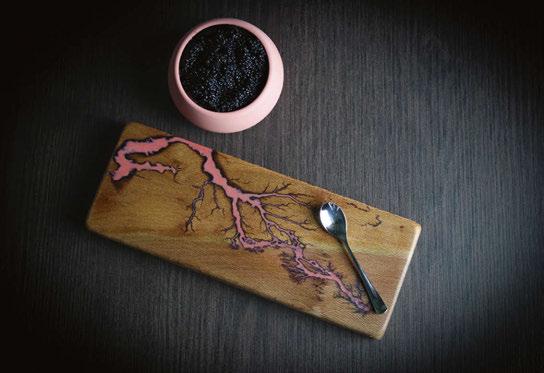
Fine Dining & Living brings together fine, contemporary and well-thought-out tableware, home and decoration brands all under one roof. Fine2Dine stands for trend-based, high-quality tableware for creative professionals, providing solutions for hotels and restaurants all over the world. Made of strong and durable porcelain, Tapa is a collection of handdipped tableware designed to surprise diners with its deep ruby colour. The contrast between the subtle sparkles in the reactive glaze and the softly speckled matt earth tones results in a stylish canvas on which to present culinary creations. With its clean shapes and refined finish, Tapa adds a southern touch to any table. www.fine2dine.com
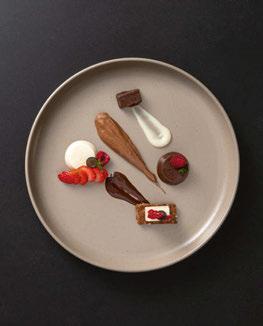
Renowned hospitality and royal household supplier Craster has introduced brass colourways to its bestselling Tilt range for elevated buffet presentations. Designed for sophisticated cuisine presentations, the Craster Tilt Brass Frames make ideal additions to all buffets and tablescapes for the summer season.

The newly added Brushed Brass collection features a precision-fitted rubber gasket, perfect for bowl and plinth grips. Available in four heights, the Tilt Brass Frames can be contrasted against monochrome bowls and plinths for dramatic culinary spreads and paired together at different levels for elevated elegance. Craster adds the Tilt Brass range as a choice beyond the sleek black or the predominant stainless steel frames. Ideal for buffets both sumptuous and exclusive, the Craster Tilt Brass Frames are subtle yet statement pieces.
With a history of forward-thinking design, Craster drives product innovation and F&B trends that reflect the use of superior material usage in the hospitality space, combining
functionality with visually stunning aesthetics to create memorable guest experiences in dining and meeting spaces.
Unveiling the intent behind the new Brass alternative, Edmund Pimm, Product Developer at Craster states: "With the addition of a brass frame to the Tilt range, we add a touch of elegance and sophistication to the existing modular buffet system. By incorporating this finish, we hope to provide even more options for creatively presenting offerings, and ultimately enhance the overall dining experience for our clients' guests."
Led by Alex Craster since 2003, the brand's intelligently designed and durable products, from conferencing and event tables to modular solution-led systems, seek to emphasise the beauty of the underlying materials from which they have been made, bolstering its position as a highly respected supplier to the world's leading hotel groups, including Marriott International, Four Seasons, Kempinski, Hilton Worldwide and IHG.
www.craster.com
Slated to open in Spring 2023, The Peninsula London is set to feature a quintessentially British curated aesthetic that is the result of special collaborations with some of the country’s most acclaimed artists and creators, including Richard Brendon. Launched in 2013, Richard Brendon is known for designing distinctive yet beautifully functional bone china and crystal using handcrafted techniques from heritage industries. By continuing to look both backwards and forwards for design inspiration, using only the finest traditional materials and working with teams of skilled craftspeople, Brendon strives to create collections to be enjoyed by generations to come – including his bespoke line of porcelain dishware for the forthcoming The Peninsula London, embellished with an exclusive 'concertina pattern. “We are excited to have enlisted the talents of these extraordinary best-of-British creators and suppliers to collaborate on important touchpoints throughout the hotel, from glassware and colleague wardrobes to original art and bespoke room fragrances,” comments Sonja Vodusek, Managing Director of The Peninsula London. “These exciting partnerships are perfectly aligned with our enduring commitment to supporting the art, culture and community of The Peninsula’s new home.”
www.richardbrendon.com
Almost a decade since Cookplay first proposed a new perspective in the world of tableware, the modern and innovative Basque brand has been building a food and design universe that is always faithful to its disruptive values with their characteristic organic design full of freshness and sensuality. Most recently Cookplay unveiled Rex, a new collection of tableware featuring a free and intuitive three-dimensional graphic pattern that adapts and accommodates following an instinctive and natural path. Each cellular shape is drawn without intention and is unique because it follows the logic of nature itself, adapting to the environment and without repetition. The resulting texture is created as a system of cellular forms that generate a visual culture drawing of a living organism and a new aesthetic expression that is presented on four flat supports and two ovoid volumes with lids. “We live in turbulent times, but our path is clearer than ever,” explains Ana Roquero, CEO and designer of Cookplay. “This collection is a welcome to the nonconformity, to free interpretation, with which we seek seduction through the textures of Rex that will become the source of inspiration for so many future dishes.”

www.cookplay.eu
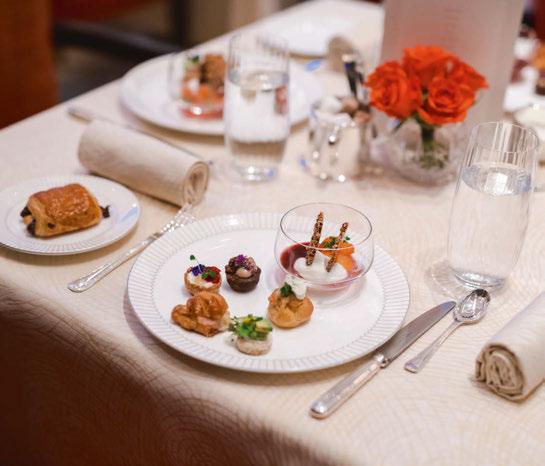
With a heritage rooted in hospitality, Amefa has been setting tables all over the world with cutlery and kitchen products since it was founded in 1931. The family-owned business prides itself on its young and dynamic team, as well as its mission to be a valued, reliable partner that provides all the benefits of a global company combined with the speed, flexibility and personal touch of a local outfit. Amefa’s newest cutlery pattern is Sierra, a refined and elegant model with round shapes and fine hammering that brings an extra bit of glamour to the table. Sierra is made from premium 18-10 stainless steel with a high gloss finish to complete a sophisticated table setting. www.amefa.com

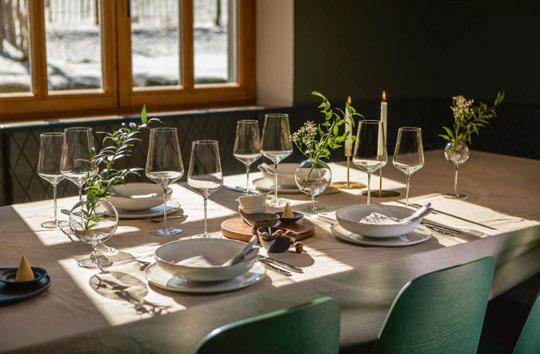
Low, open, elegant and very wellbalanced, the Saturno Coupe is a collection developed so that each gastronomic creation is part of a sensory whole, with a special focus on plating. Designed by Studio Levien for Costa Verde, the series comprises 10 different pieces ranging from a serving dish to plates of various diameters. Founded in 1992 as one of the more contemporary companies in the sector, Costa Verde is not only rooted firmly in the Portuguese market, but – following more than 30 years of steady growth – also benefits from myriad fruitful partnerships that have emerged from marketplaces around the world.

www.pro.costa-verde.com/en
William Edwards has introduced a series of fine bone china to celebrate the coronation of His Majesty King Charles III. The Coronation collection features a bold and intricate design that gently adorns the shape of each piece. Skillfully hand-decorated in the heart of the worldrenowned Potteries in England, notable elements include the iconic St Edwards Crown motif and four floral symbols representing England, Wales, Scotland and Ireland. The commemorative range comprises a coaster/ trinket tray, King's Coronation mug, couple plate, teacup and saucer set, trinket box and a limitededition large bowl. www.williamedwards.co.uk

After celebrating its 150th anniversary in 2022, German glassmaking company Zwiesel Glas has unveiled Fusion, a new filigree glass experience that showcases the harmonious interplay between man and machine through a composition of two parts that become one. Traditional handwork merges with state-of-theart machine precision; the soft and particularly fine feel of the wafer-thin stem is created by human hands, while the impressive stability and elegant bowl in this series are produced by machines. Made with Tritan crystal glass, Fusion features the perfect pieces for serving Bordeaux and Burgundy, light and strong white wines, or even Champagne.
www.zwiesel-glas.com
Corby Hall, a family-owned business based in New Jersey, USA, has supplied the international hospitality industry with high quality flatware, holloware and bright white porcelain dinnerware for the past 40 years. The brand offers designs ranging from traditional to contemporary at competitive price points, and has the ability to supply any F&B outlet associated with a full-service foodservice operation.

In fact, Corby Hall was one of the very first companies to introduce 18/10 stainless steel flatware and holloware. Its global distribution network, coupled with production facilities in Europe and Asia, allow for seamless service for both opening orders as well as re-supply. www.corbyhall.com

Specialist Spanish tableware company Pordamsa has launched a new collection of black porcelain. Modelled by hand from black porcelain paste and fired at over 1300ºC, the range bears a finish never seen before by the brand and inspired by the colour black night. This novelty inspires the creation of gastronomic proposals that contrast with the aesthetics of the product. Founded in 1975, trend-setting porcelain and glass manufacturer Pordamsa creates exceptional articles that currently accompany the creations of the most renowned international chefs and provide solutions for the most demanding hotel design projects.
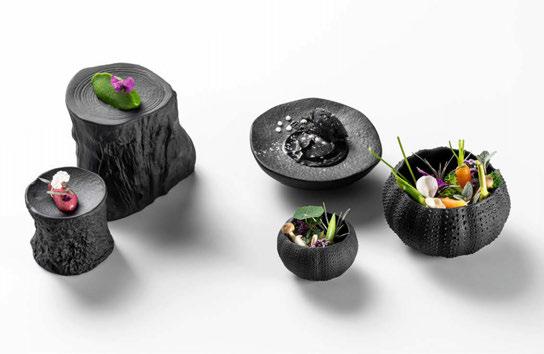
www.pordamsa.com
Designed by Gio Ponti in 1932 and still in production today, this cutlery collection is an icon that Italian brand Sambonet dedicated to the contemporary table. Since 1856, Sambonet has conceived, designed and produced stainless steel cutlery and tableware. The excellence of its products lies in its Made-inItaly technologies, from galvanic silverplating to innovative PVD colouring, as well as the selection of special finishes on offer. With more than 40 models of cutlery and an unrivalled range for each collection – all individual cutlery, from serving piece to butter spreaders, including sauce spoons, gourmet spoons, and many more – the brand meets every stylistic and functional requirement of industry professionals, whilst always remaining a forerunner of new trends. Along with German Rosenthal porcelain, French Ercuis and Raynaud brands, Sambonet is part of the Italian Arcturus Group, a leading international manufacturer of high-quality design tableware, dinnerware and cookware, both for the home and HoReCa sector.
www.sambonet.com
Eva Karlsson, President of Other Global Vertical Segment at Dometic, sits down with Supper to talk about the role of technology in the hospitality experience, the advent of mobile food delivery services and sustainability.
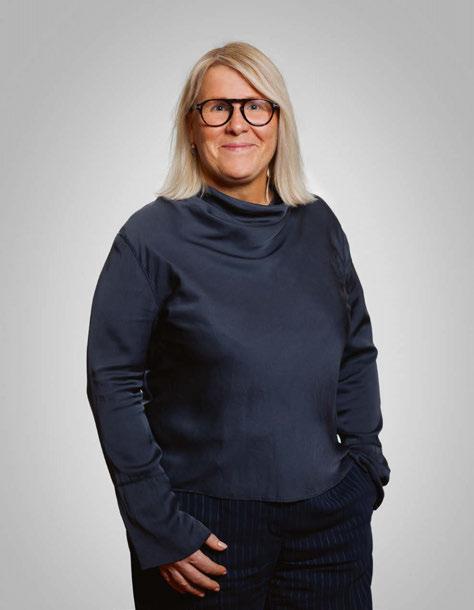
What kind of solutions does Dometic offer to the hotel sector?
We offer a wide selection of premium minibars, safe locker solutions and wine refrigerators for restaurants and outdoor mobile bars to give guests an exclusive drinks experience.
How can your technology enhance the hospitality experience?
Our absorption-cooling technology for minibars is completely silent, making it ideal for guest spaces such as suites, lounges or spas. Defined by its sleek, Scandinavian minimalist design, our products are created with sustainable energy consumption top of mind and boast reduced consumption compared to other minibars on the market. Our minibars are also 100% chromate-free, meeting the latest EU legislation. We could keep the performance with our R&D effort and replace it with an environmentally sound substance that would have the same anti-corrosive effect as the well proven chromate. Our expertise in outdoor products has enabled us to develop and create durable yet elegant outdoor beverage centres such as the Dometic MoBar for hospitality businesses to stylishly entertain their guests in outdoor spaces like patios, terraces or balconies.
What sets Dometic apart from other brands in the industry?
Our strength is our global presence, scale and capability to meet demands from our customers who are global luxury brands in the hospitality sector. From technology to production facility, we can deliver the products that satisfy our customers needs.
How has the advent of mobile food delivery changed how you operate?
Mobile food delivery brought a good opportunity for us, a company who owns technologies to support their business. Our innovation of food delivery box Dometic DeliBox is a great example of a premium delivery box that boosts the home delivery service and increases customer satisfaction. As the first of its kind, the Dometic DeliBox preserves the restaurant quality and temperature of the food until it reaches the customer. The unique DeliBox has both active heating and cooling which means a hot pizza and chilled salad can be delivered at the same time. It also has smart functions such as modular compartments, lighting, CleanAir technology and a lock to keep the food safe.
How
As a Swedish brand and global leader in the business, our approach with a focus on sustainability is sometimes a clear differentiation in the market. As said, our products are created with sustainable energy consumption top of mind, boasting reduced consumption. Our 100% chromate-free minibars are a great example of our approach in sustainability. In fact, our Hipro Alpha/ Evolution Compressor minibars are not only Energy Star certified in the US, but they have also been classified as the Most Efficient 2023 in its category.
Our motivation is to create smart, sustainable and reliable products with outstanding design for outdoor and mobile lifestyle. We continue to support our customers in the hospitality industry with new innovative solutions and help them deliver unforgettable moment for their guests.
www.dometic.com
June 13-14, 2023



INDUSTRY CITY | BROOKLYN, NY
BAR CONVENT BROOKLYN (n). A welcoming and collaborative environment in which the pioneers of the bar and beverage community gather to celebrate and sculpt the future of liquid culture through education, sharing best practices, and generating business opportunities. A curation of the most premium brands driving the cocktail movement. BUY
BCBBROOKLYN23.COM/SUPPER

22-24 2023
350+ EXHIBITING COMPANIES
4 WORLD COFFEE CHAMPIONSHIPS
2 ROASTER VILLAGES
SCA LECTURES
WORKSHOPS
CUPPING ROOMS
BREW BAR
ESPRESSO BAR
GREEN COFFEE BUYERS AND SELLERS PROGRAM
BEST NEW PRODUCT
COFFEE DESIGN AWARDS
NETWORKING, AND MORE!
There’s nothing quite like heading into the mountains to work up an appetite – especially at L’Apogée Courchevel, where alpine dining was given a dash of adrenaline over the winter with the introduction of a VIP culinary experience that saw Executive Chef Jean-Luc Lefrançois dazzle guests both on and the off the slopes.

The gastronomic luminary and self-confessed black run enthusiast made time during the season to set down his knives and carve powder instead, accompanied by guests at the Oetker Collection property who were happy to ski for their supper and discover more about his twin passions: snow sports and cooking.
The all-day experience comprised a morning workout on the resort’s glistening peaks, with the chef leading guests through a session of alpine skiing, cross-country skiing or ski touring
tailored to their personal preference and ability, followed by an al fresco picnic-style lunch preprepared by Lefrançois himself. Highlights from the seasonal menu included hearty yet refined dishes such as scallops with French caviar, quinoa with roasted winter root vegetables and sour mango and fresh truffles, rounded off with a classic pavlova.
After more time on the skis to burn off the calories, it was back to L’Apogée Courchevel for late afternoon, where the guests unwound over champagne while the culinary star swapped his salopettes for his chef whites. To polish off the experience: a personalised cooking demonstration centred on preparing sea bass in a pistachio crust – the signature dish served at the hotel’s gastronomic Japanese restaurant Koori. Après-ski never tasted so good.
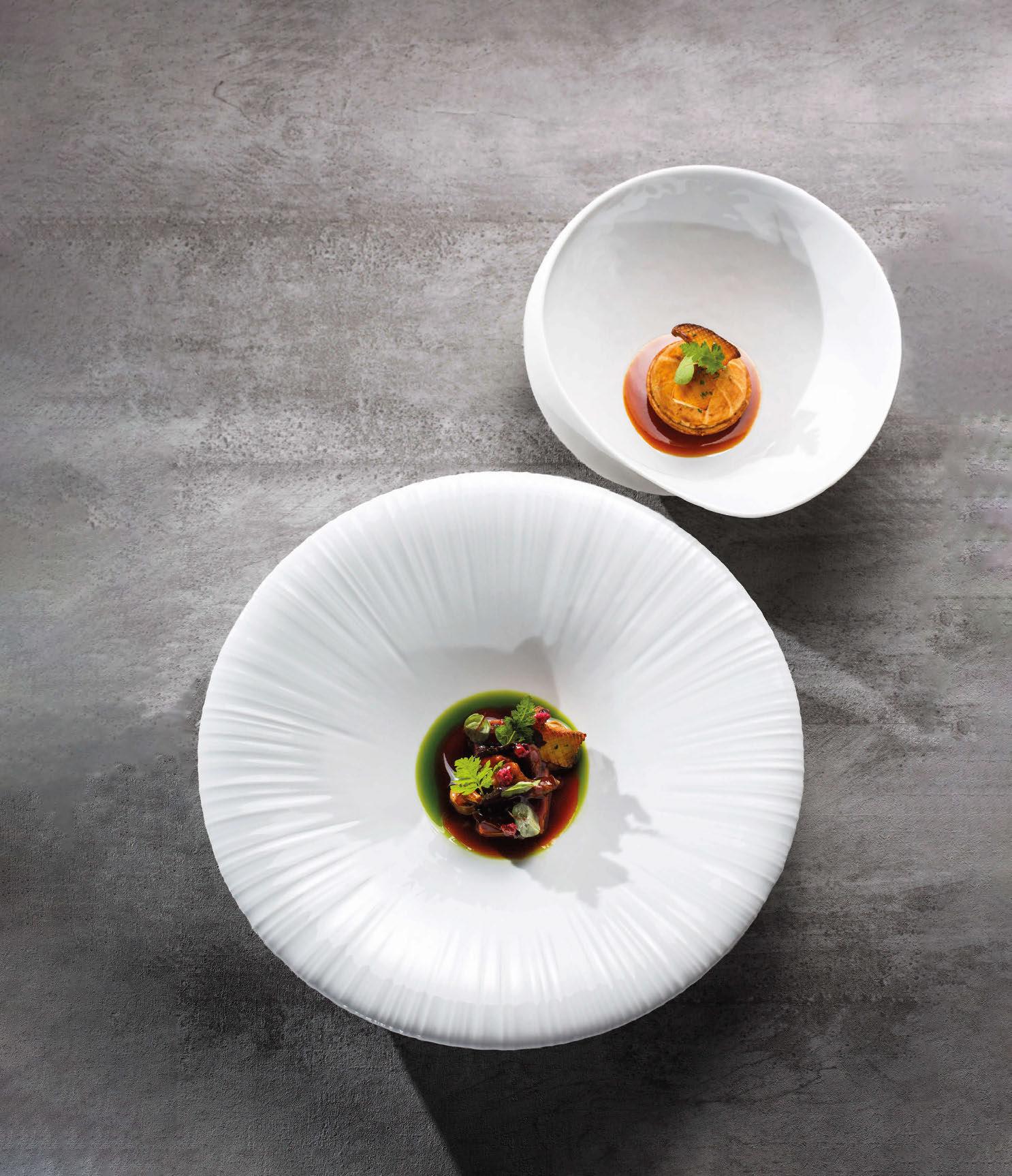
The best porcelain by the hands of the greatest chefs.REEF by Jorge Rausch TOTEM by Hermanos Torres

